

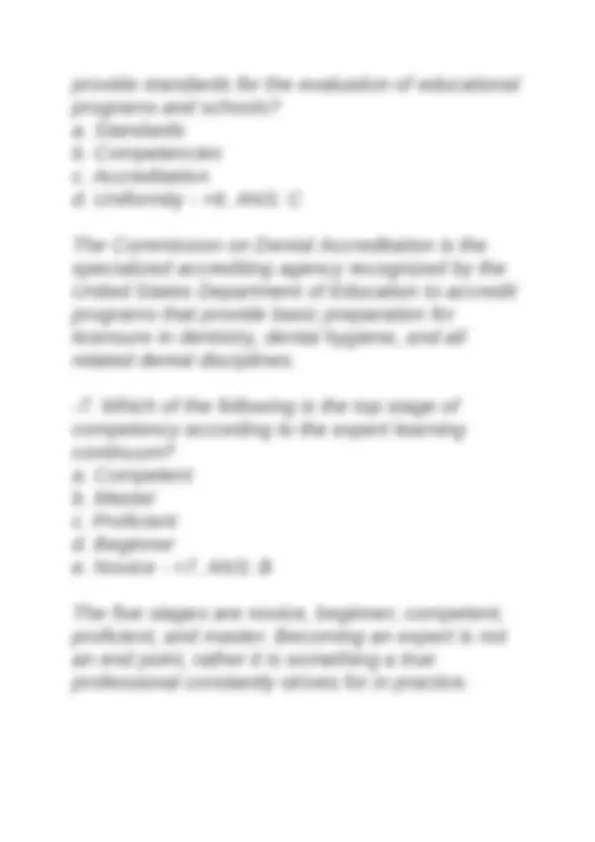
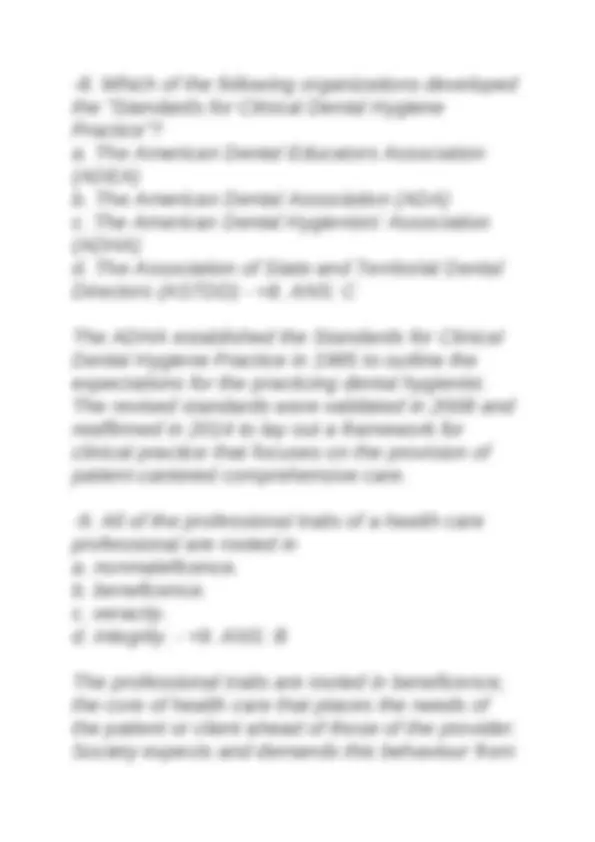
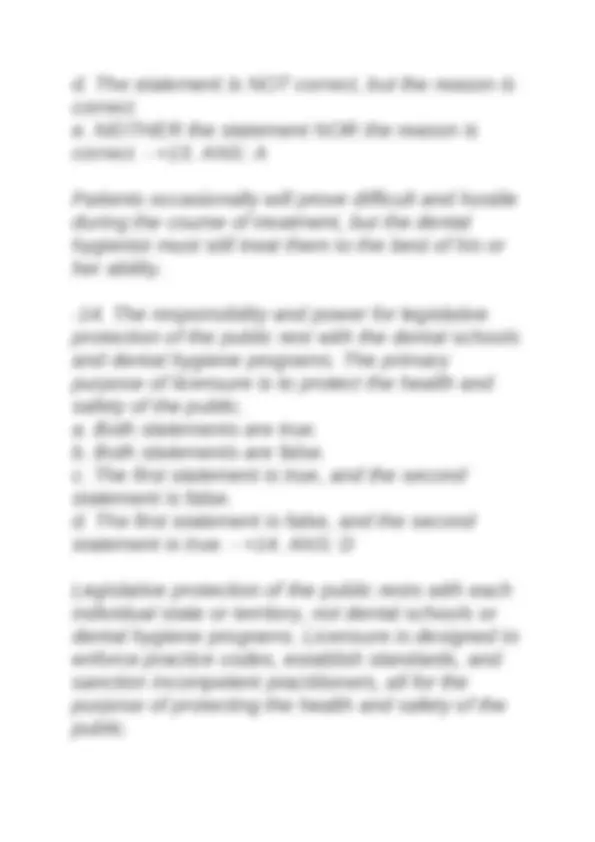
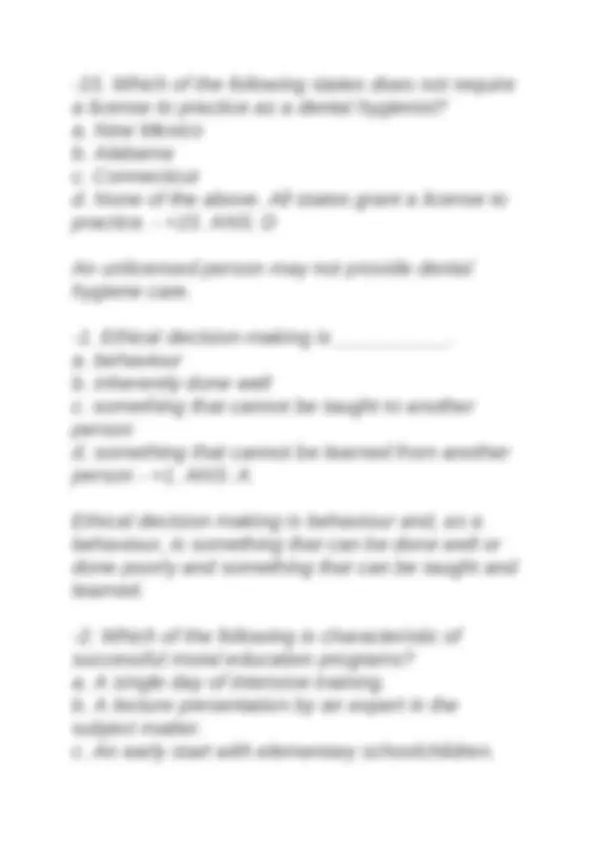
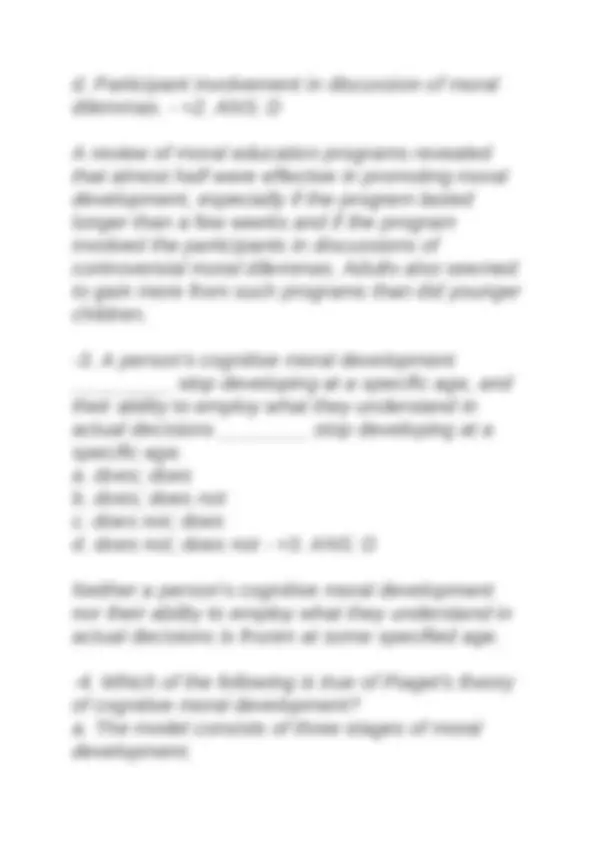
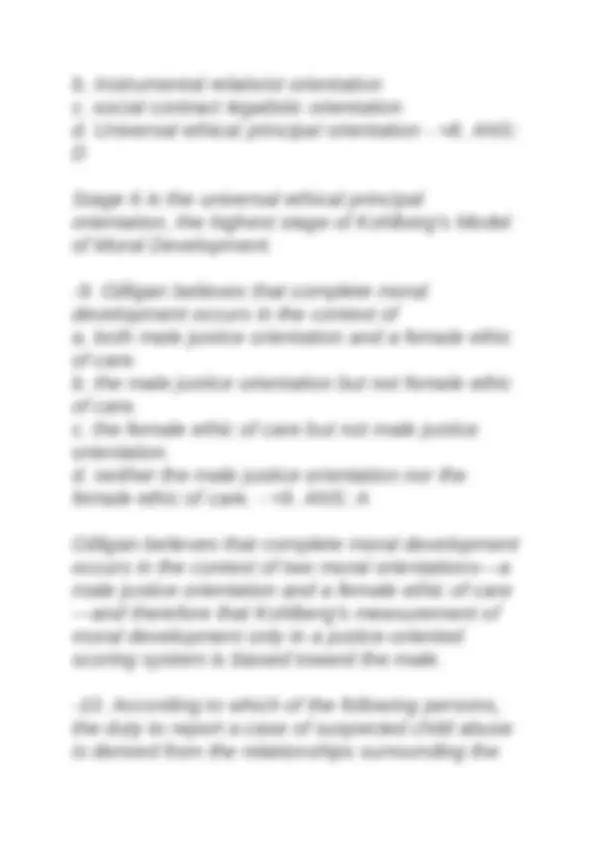
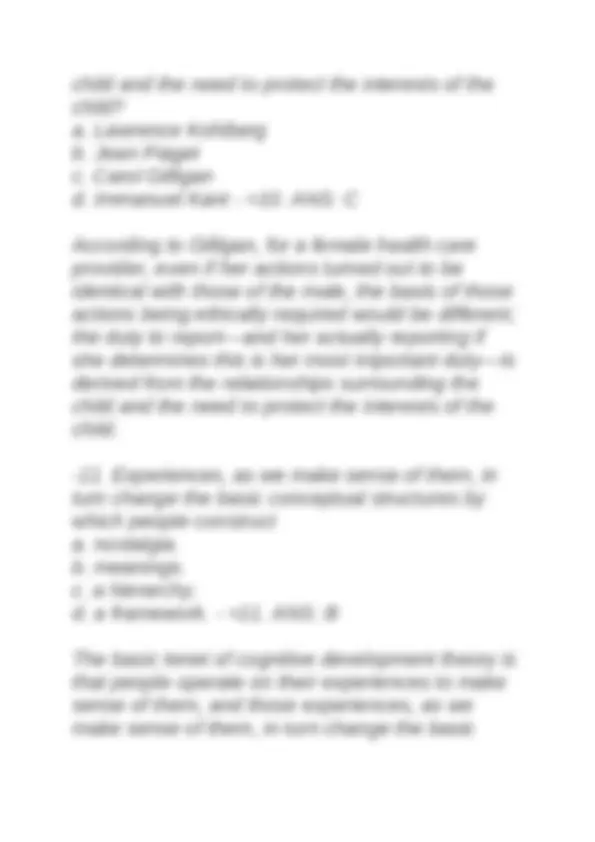
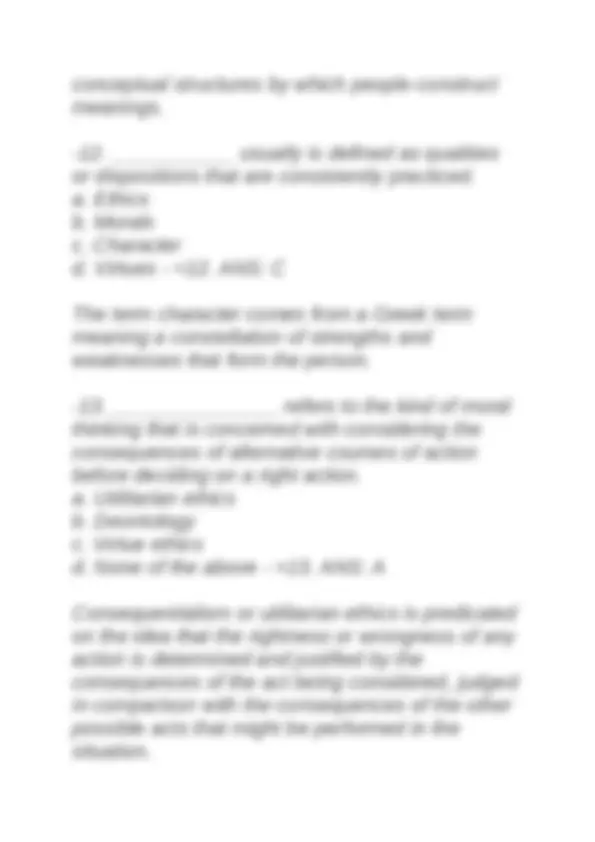
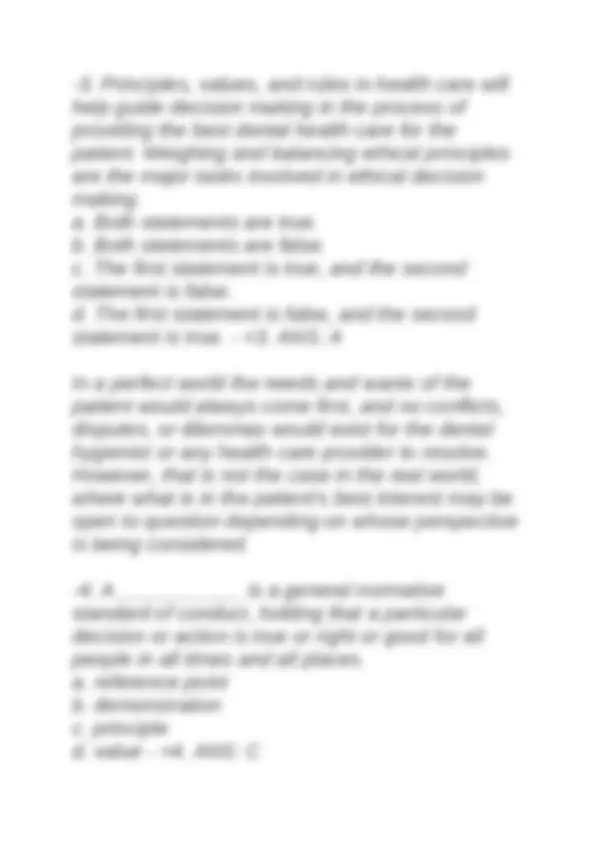
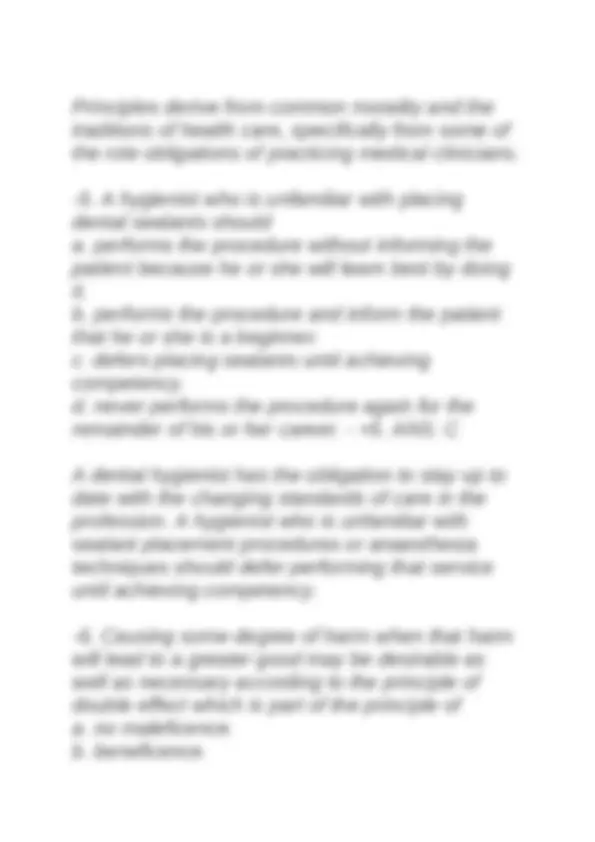
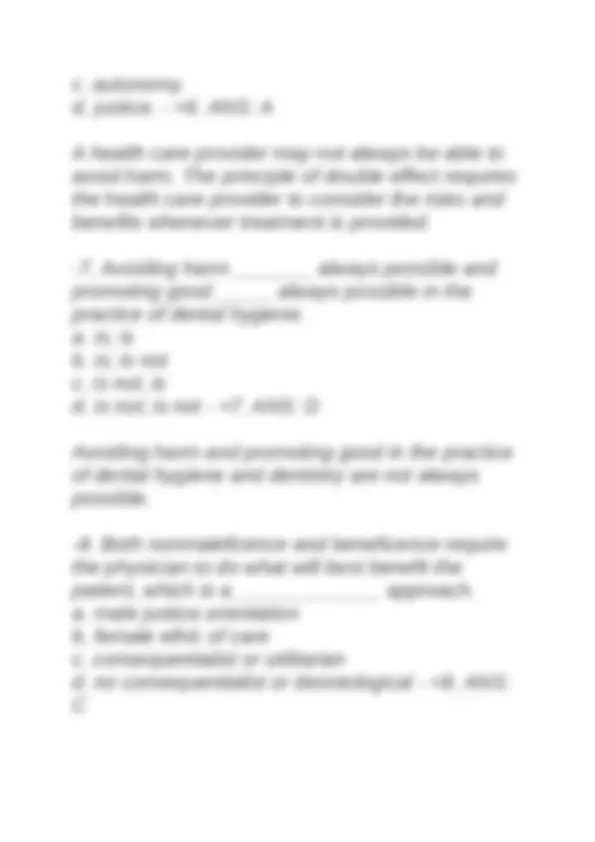
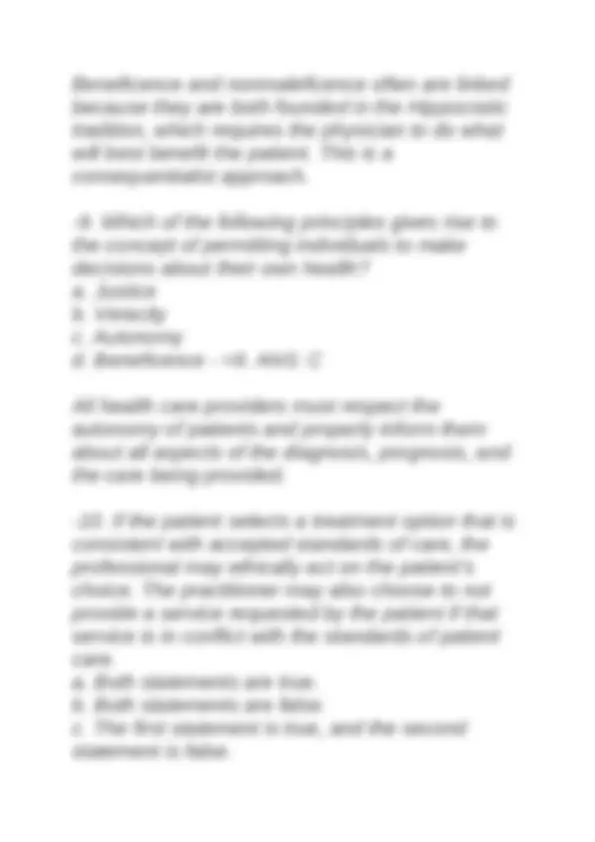
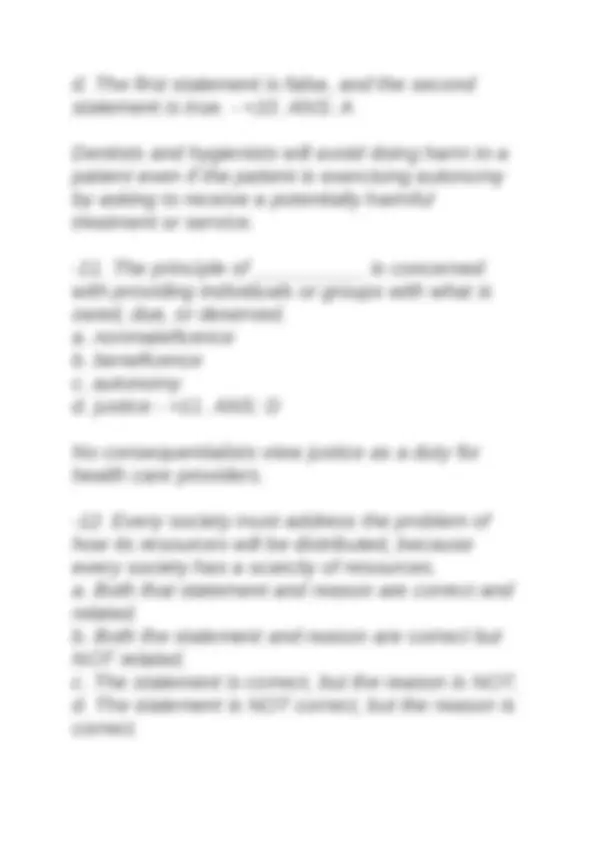
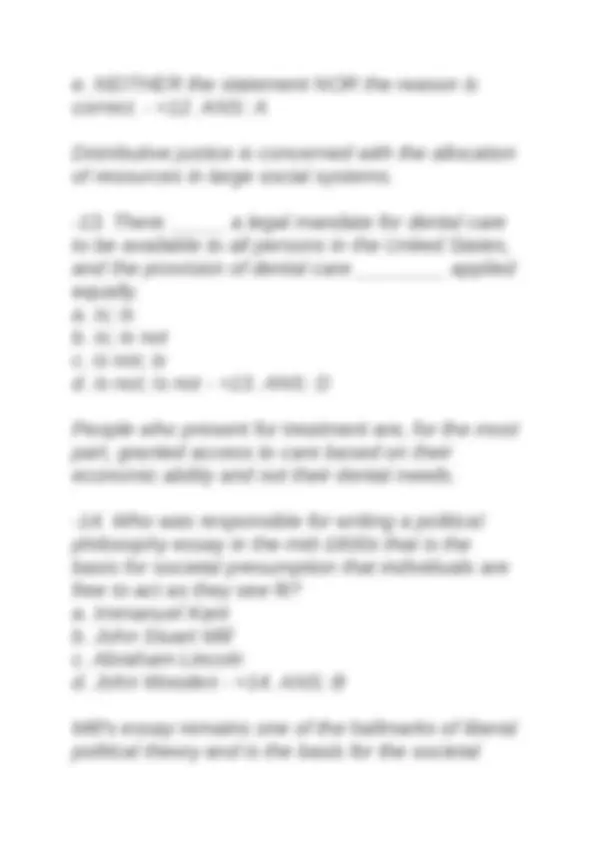
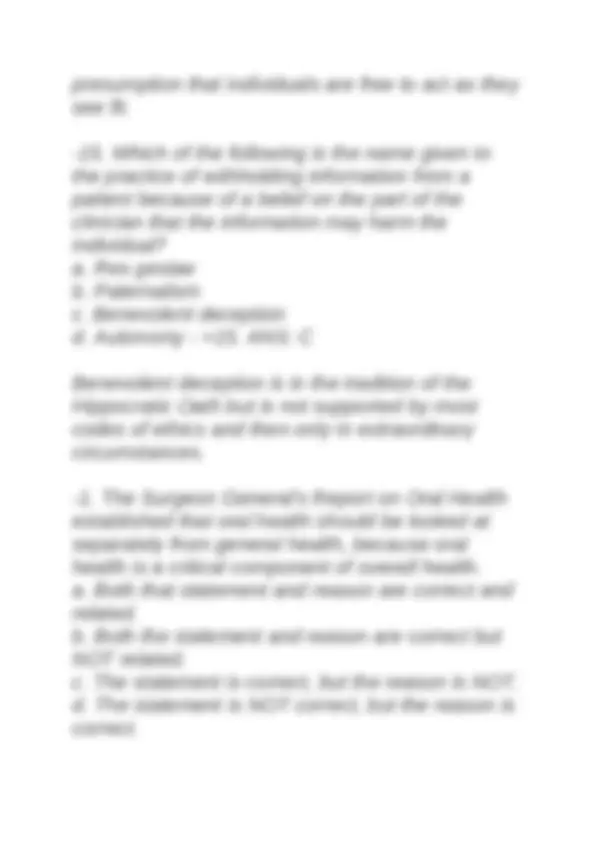
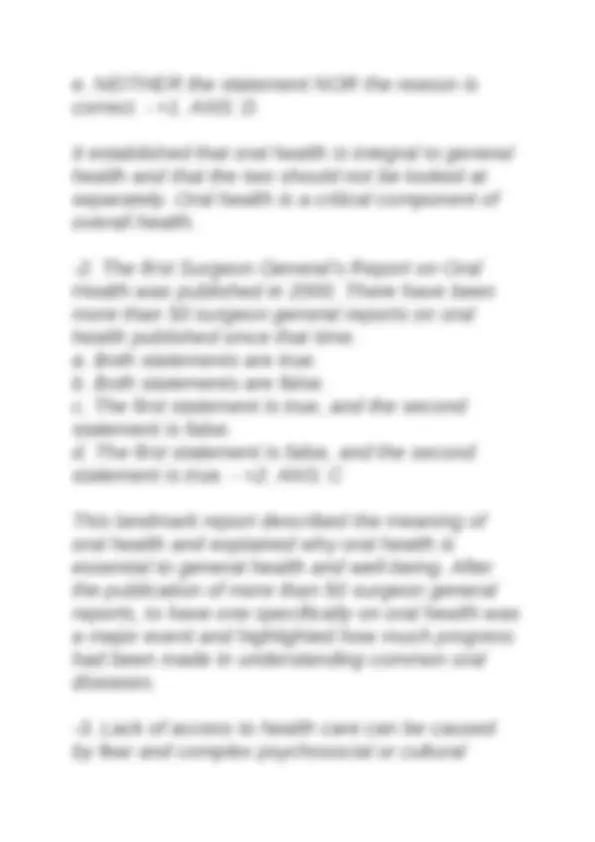
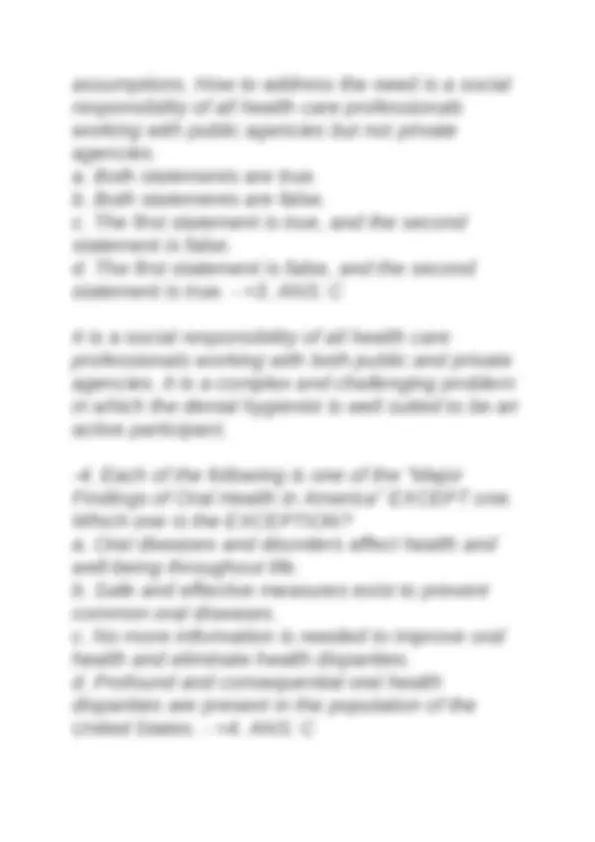
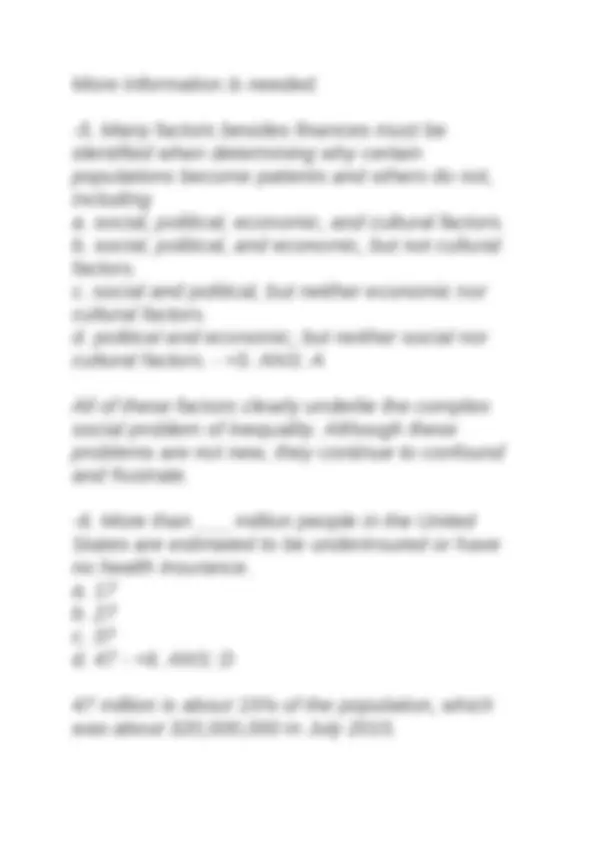
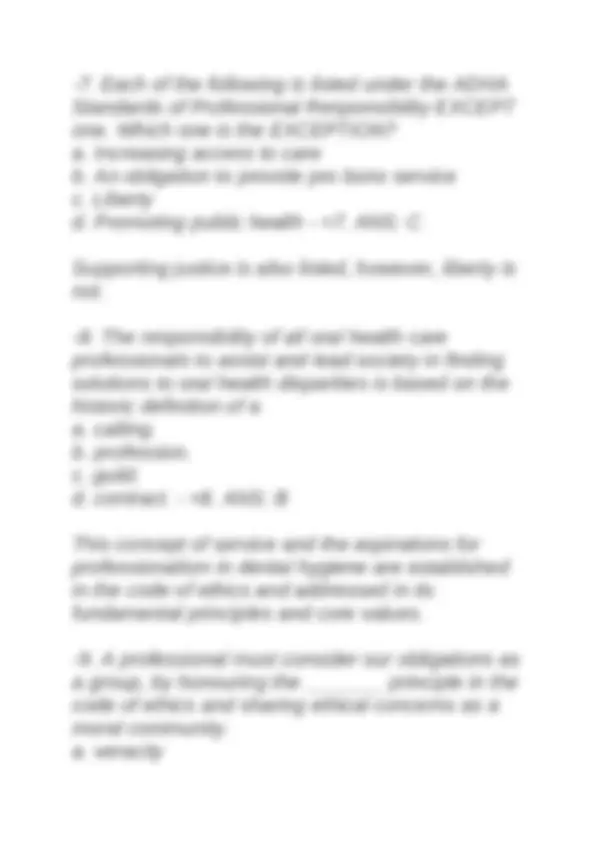
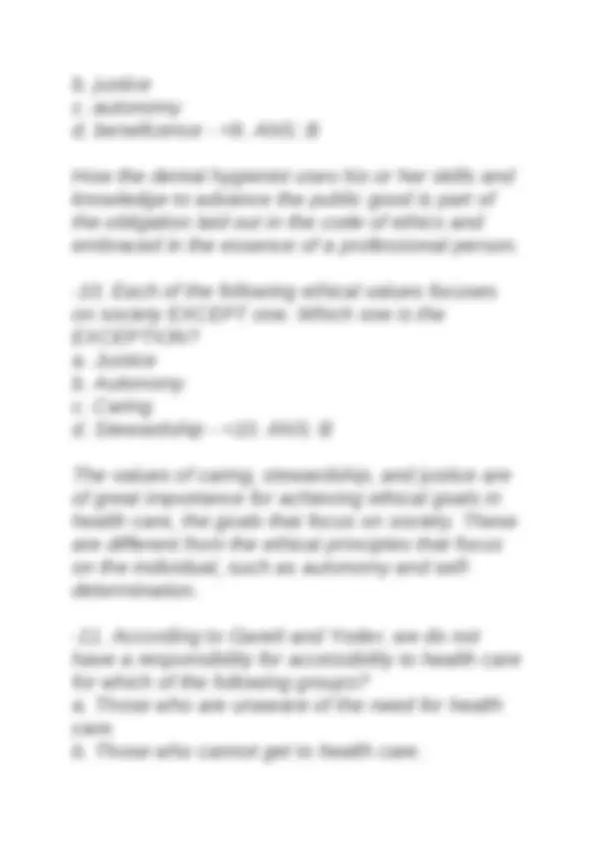
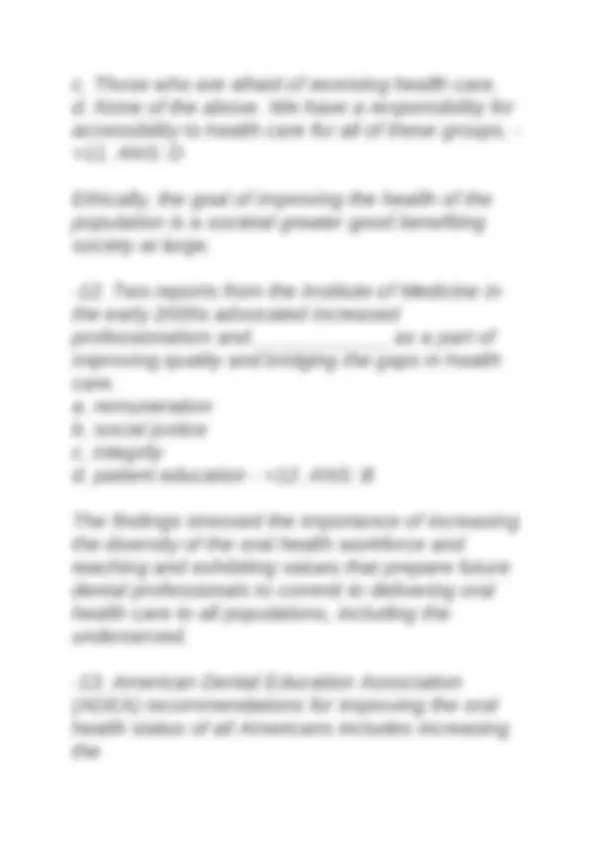
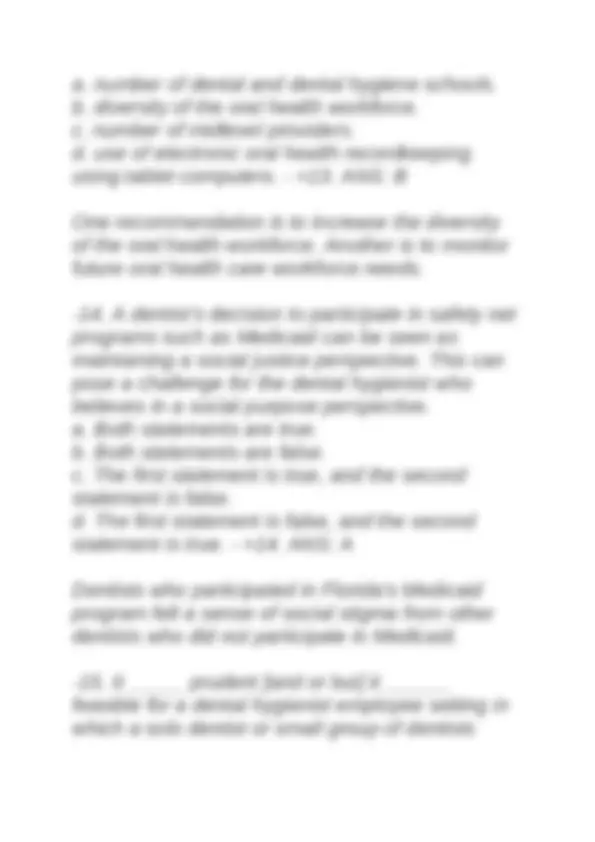
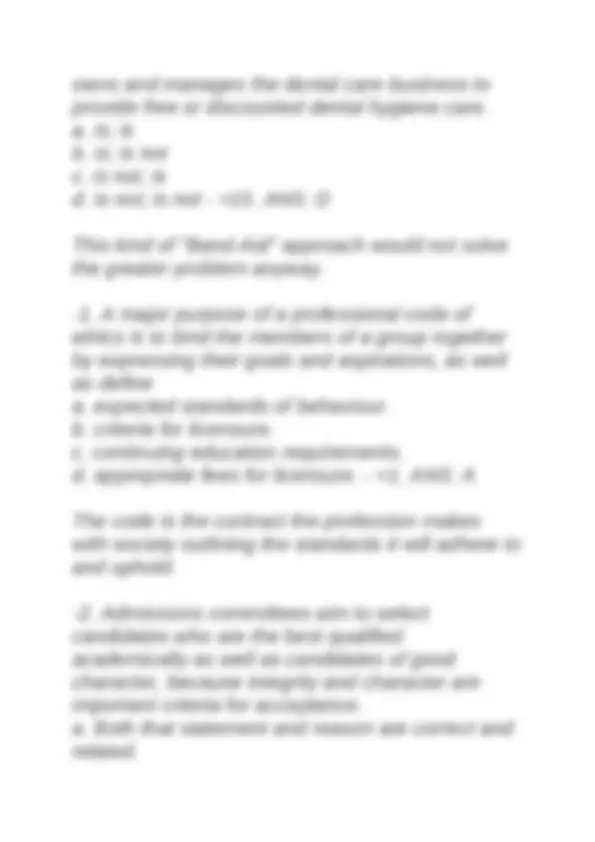
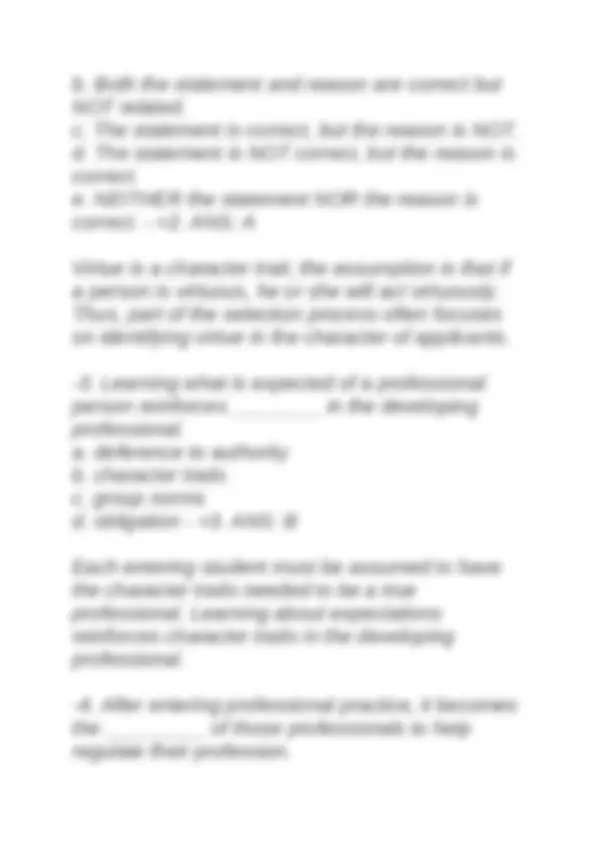
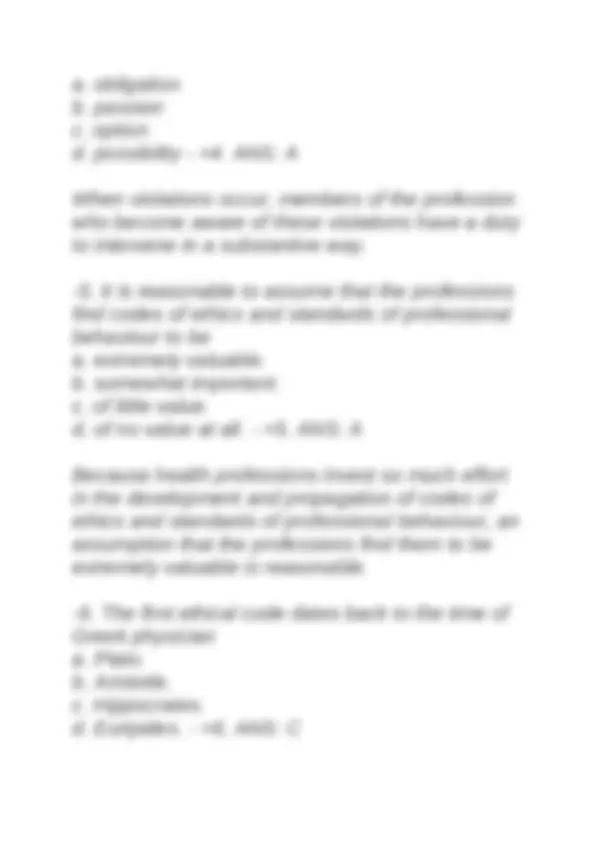
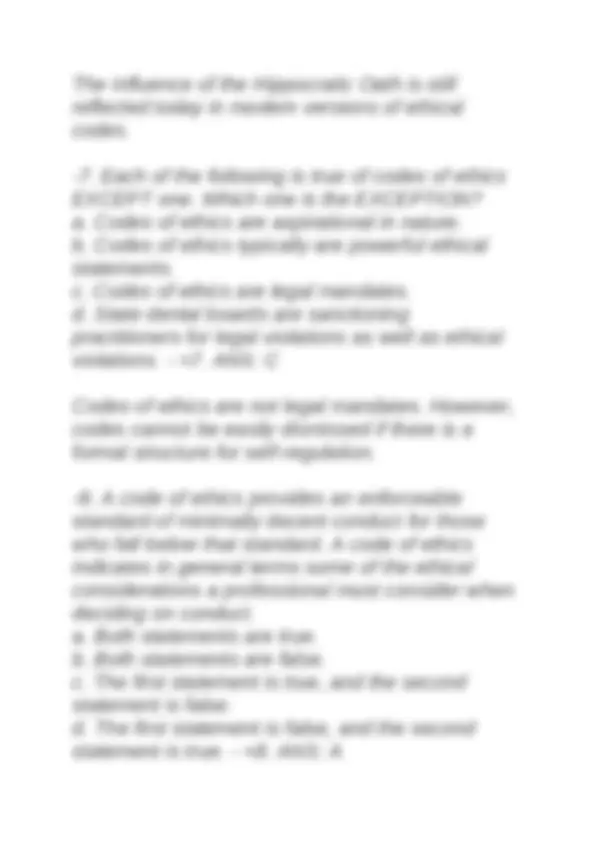
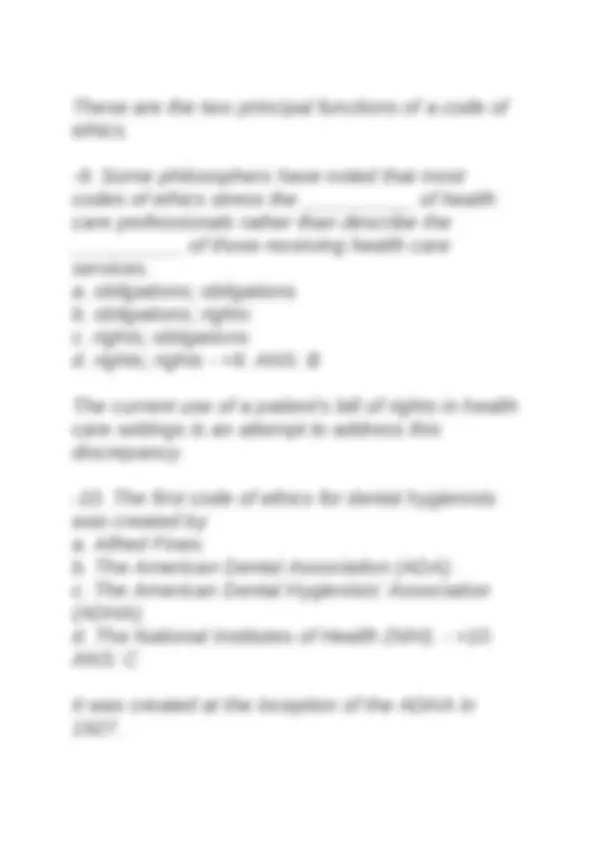
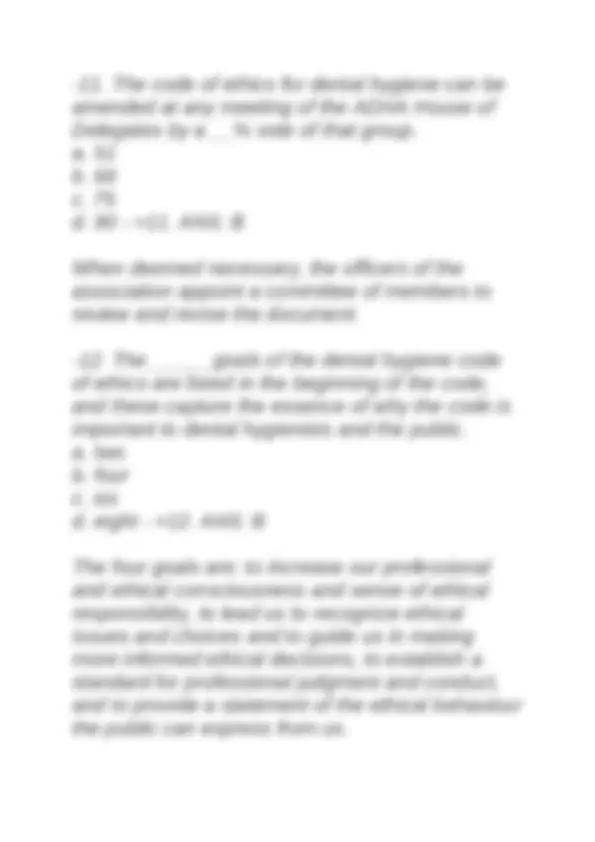
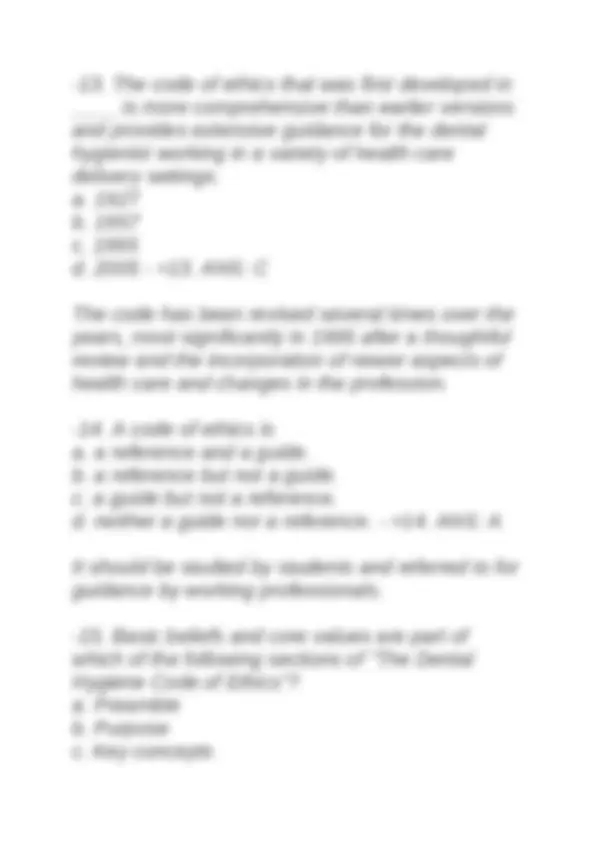
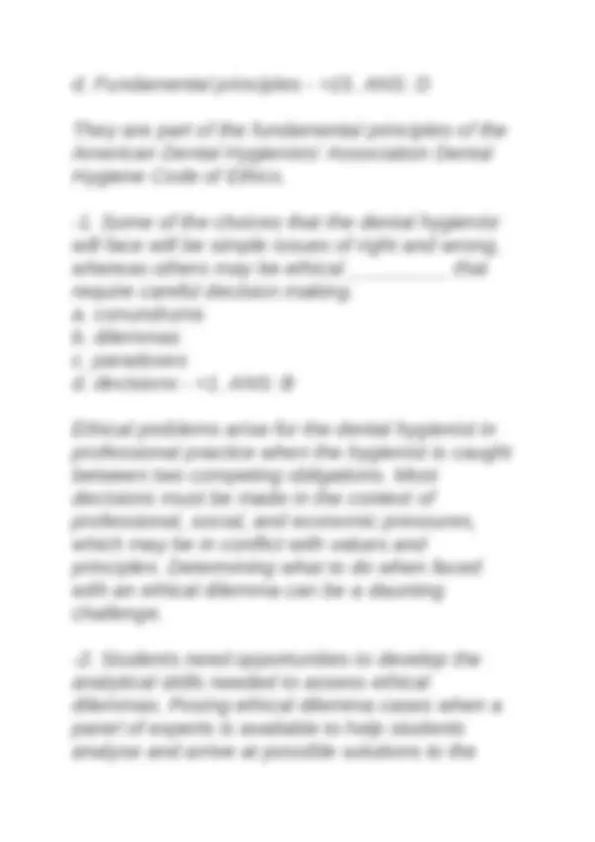
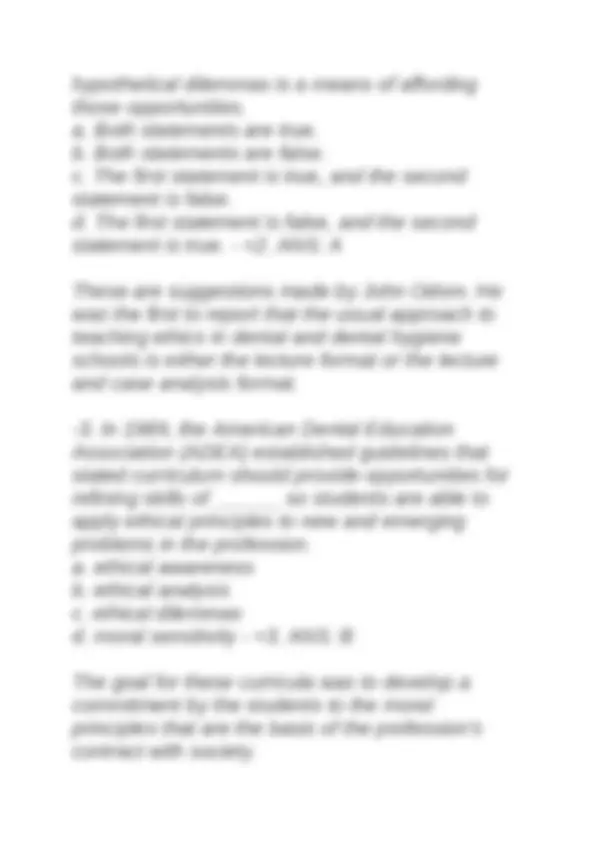
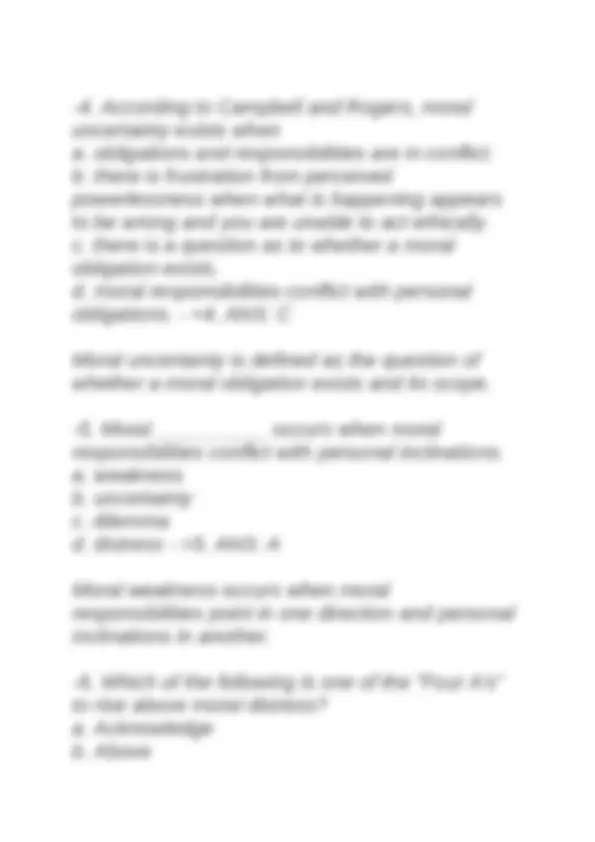
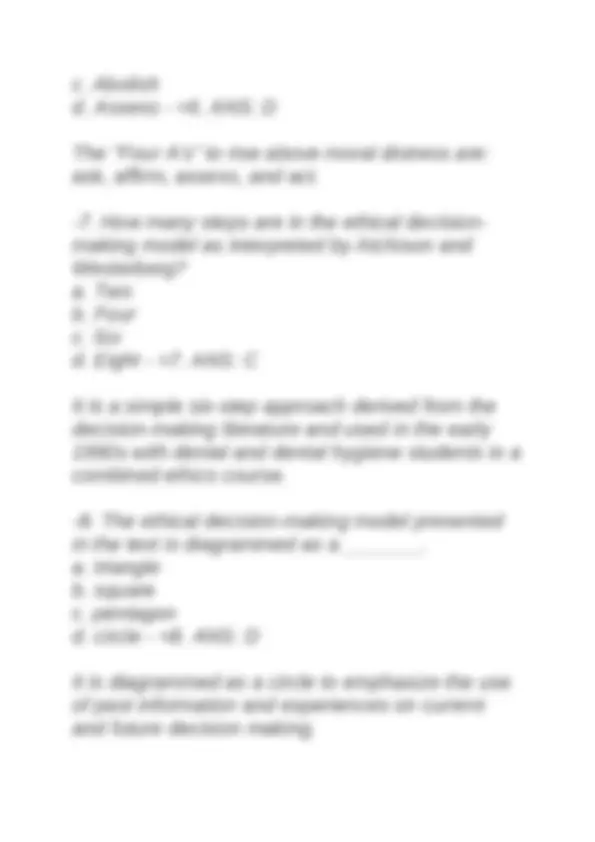
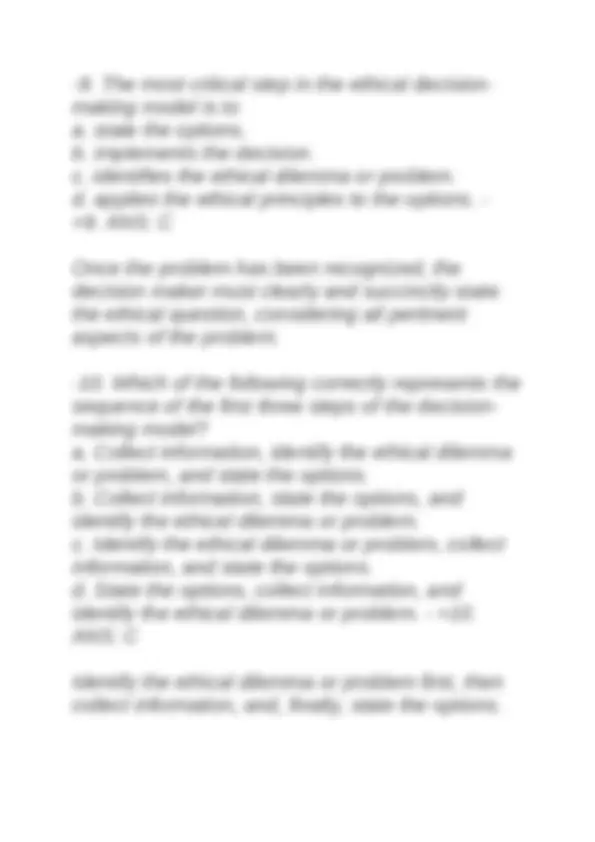
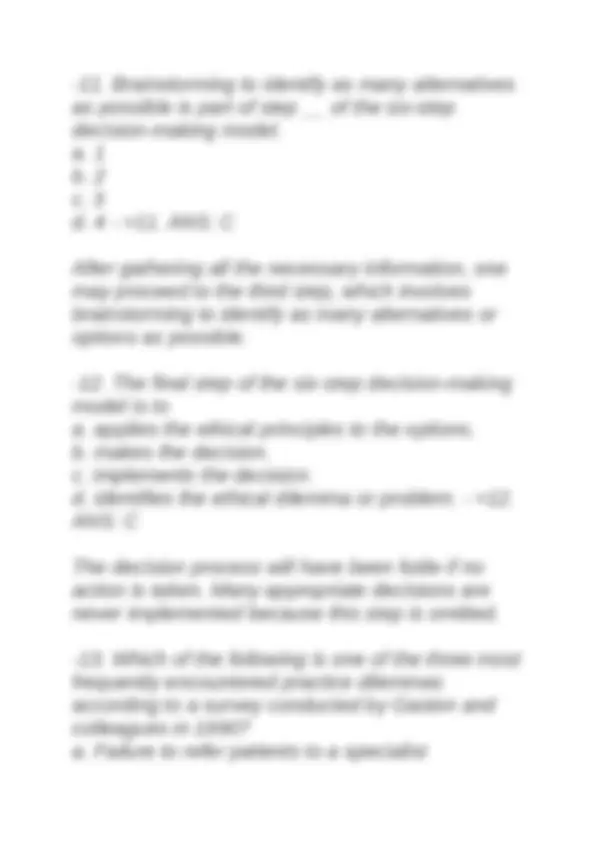
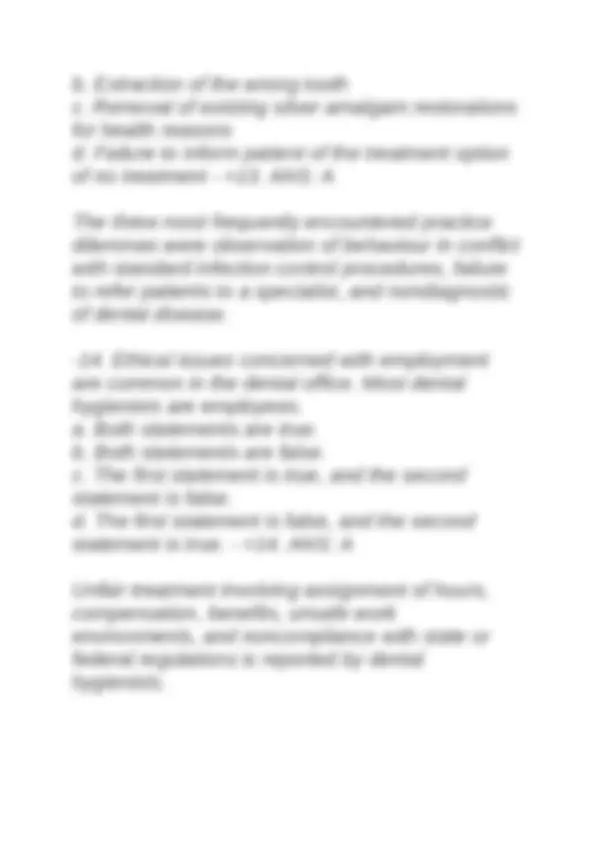
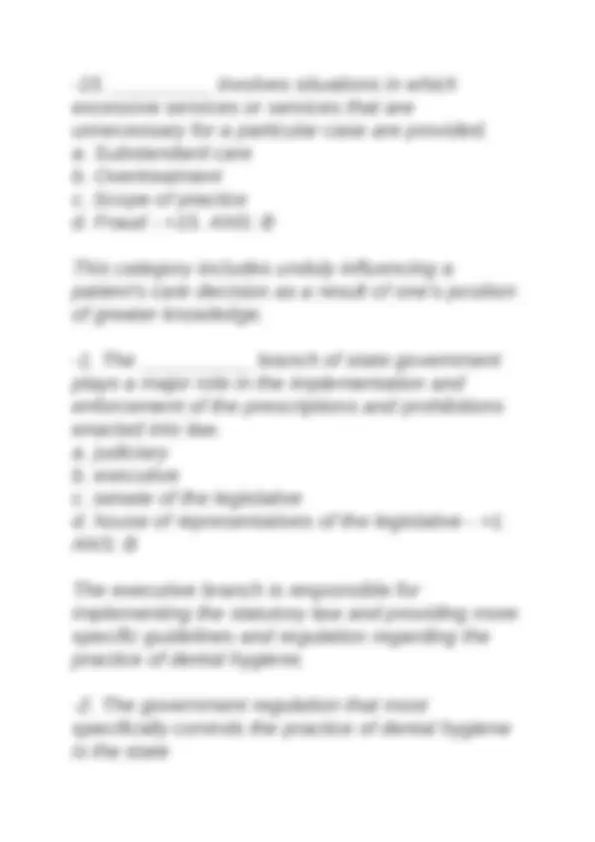
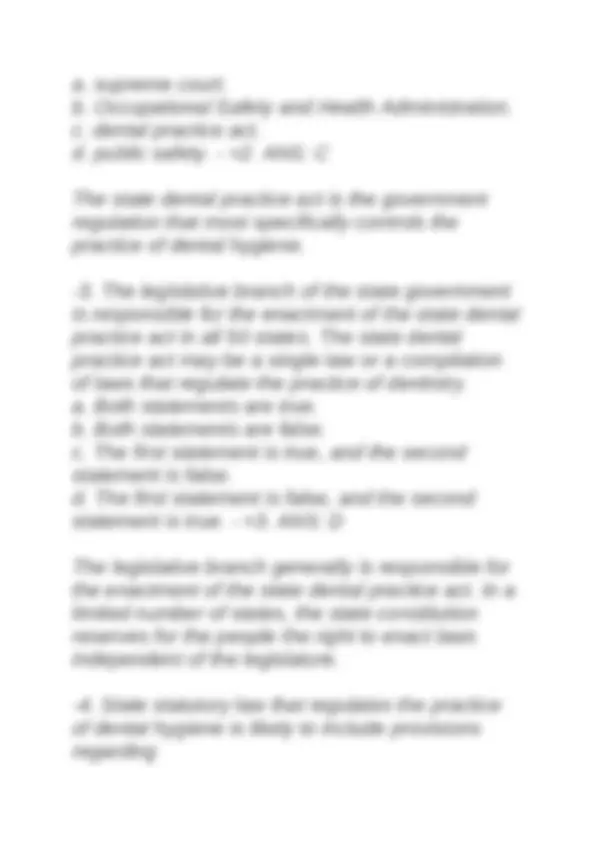
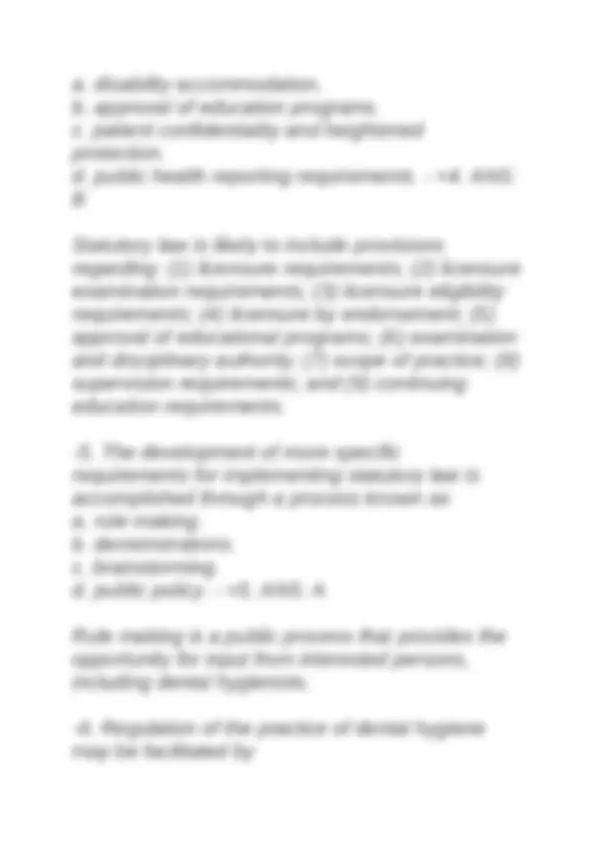
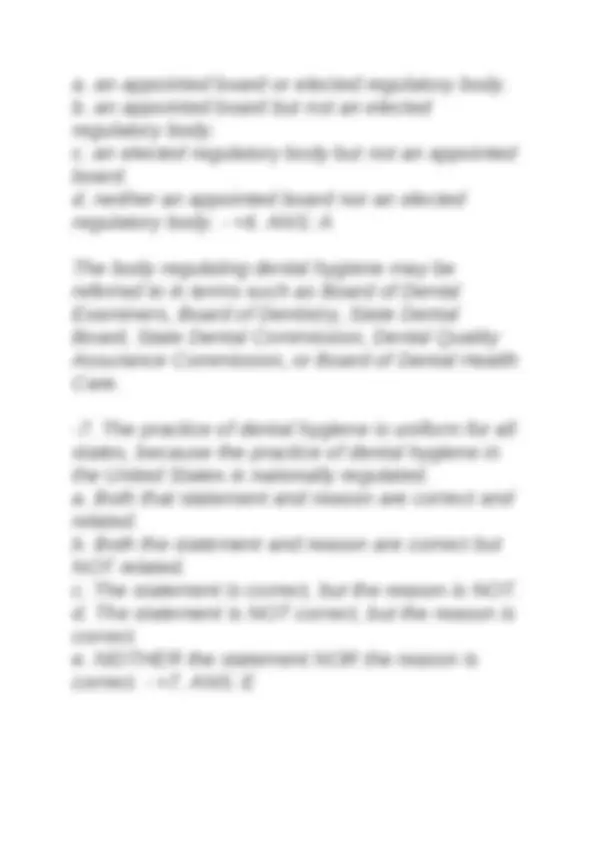
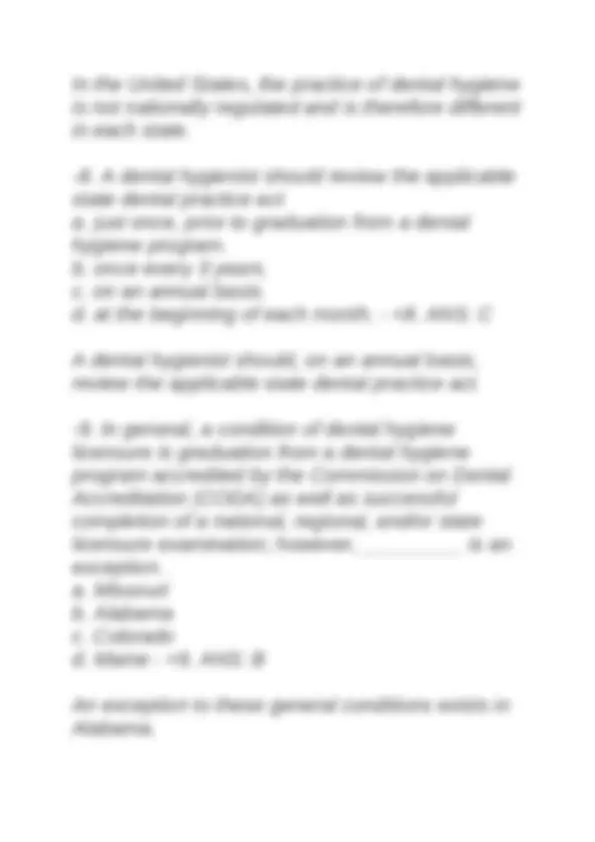
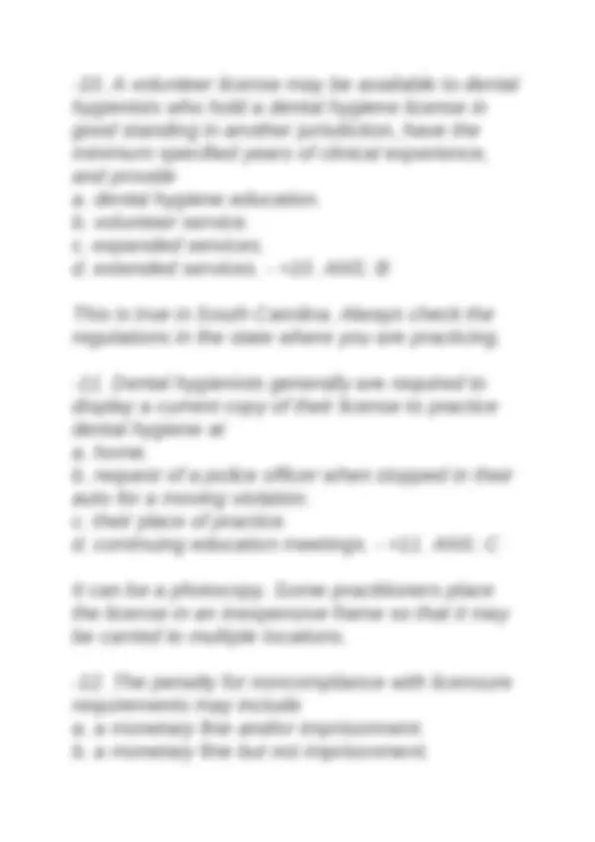
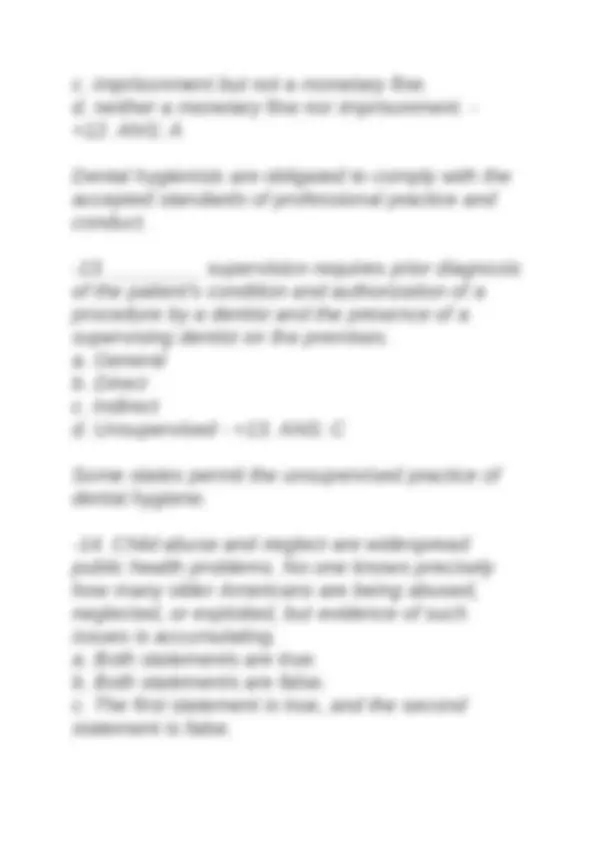
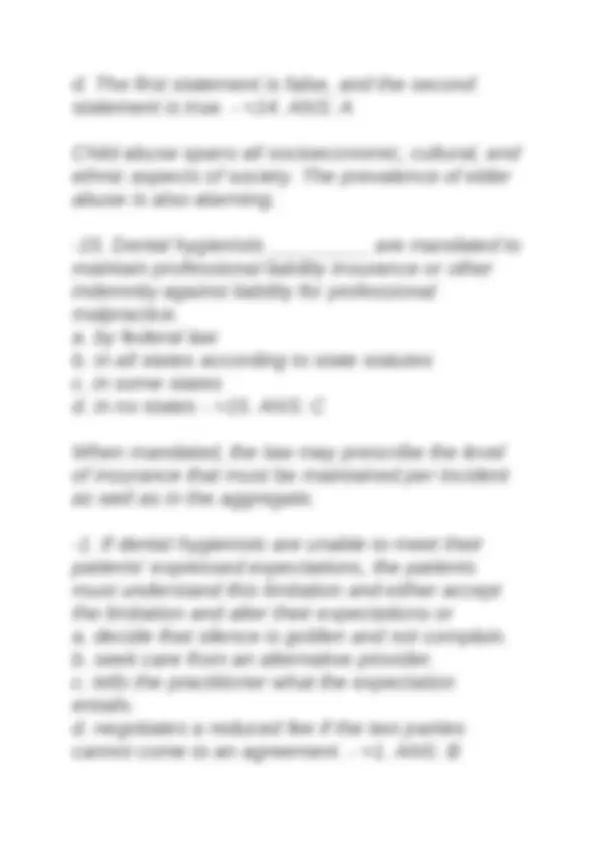
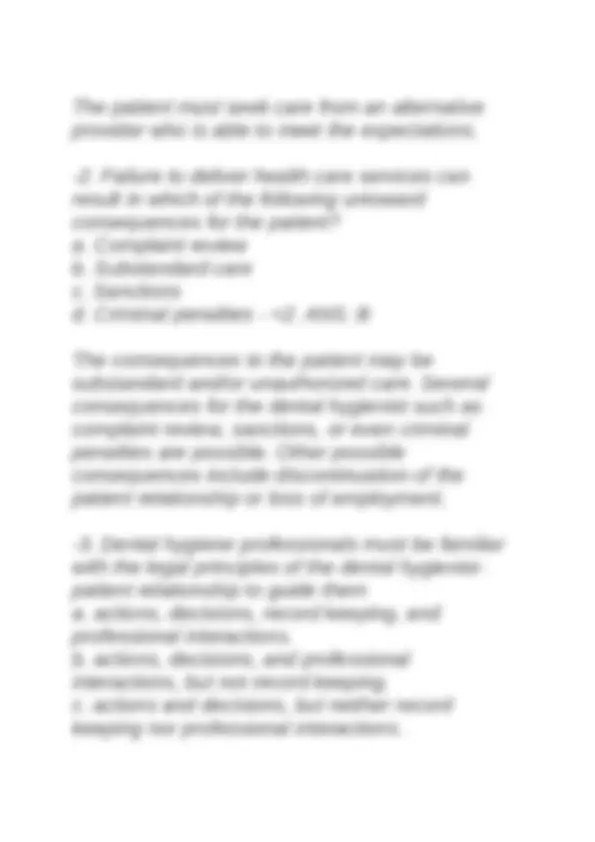
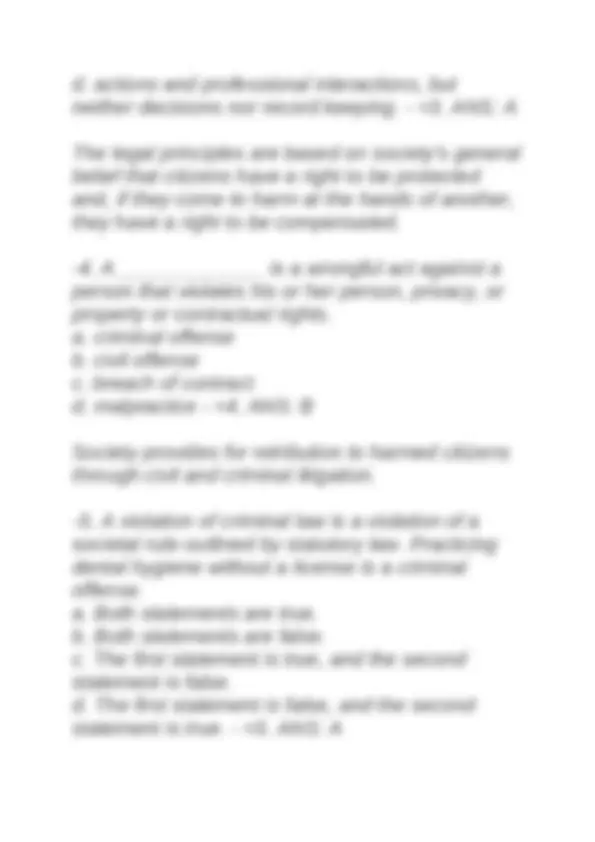
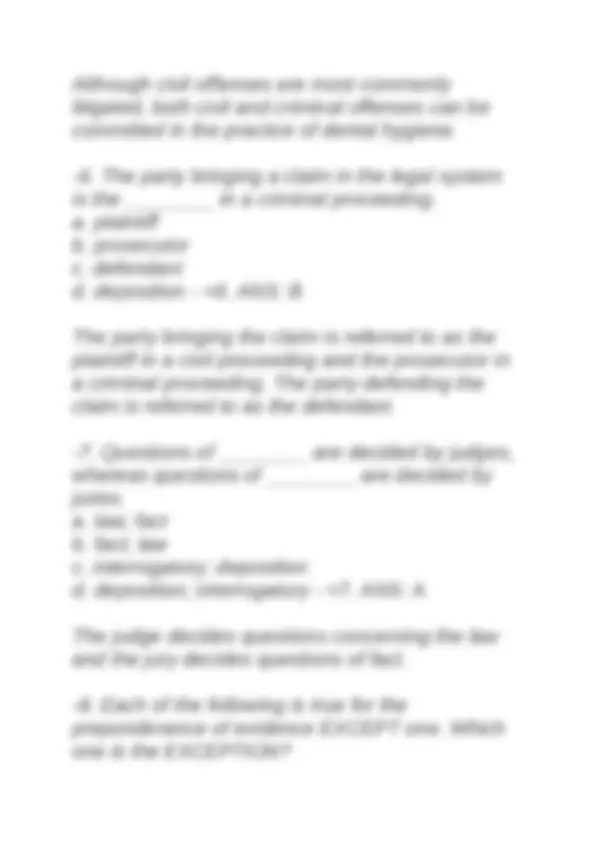
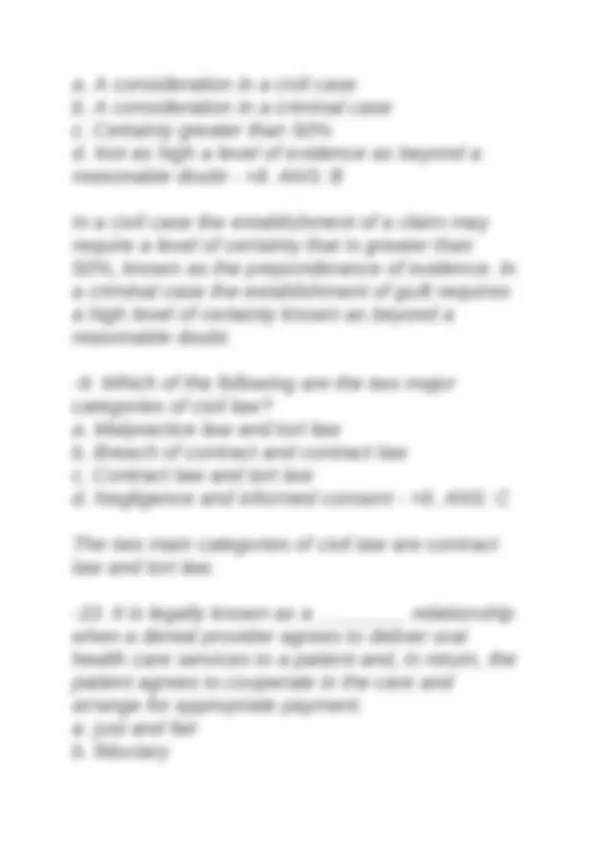
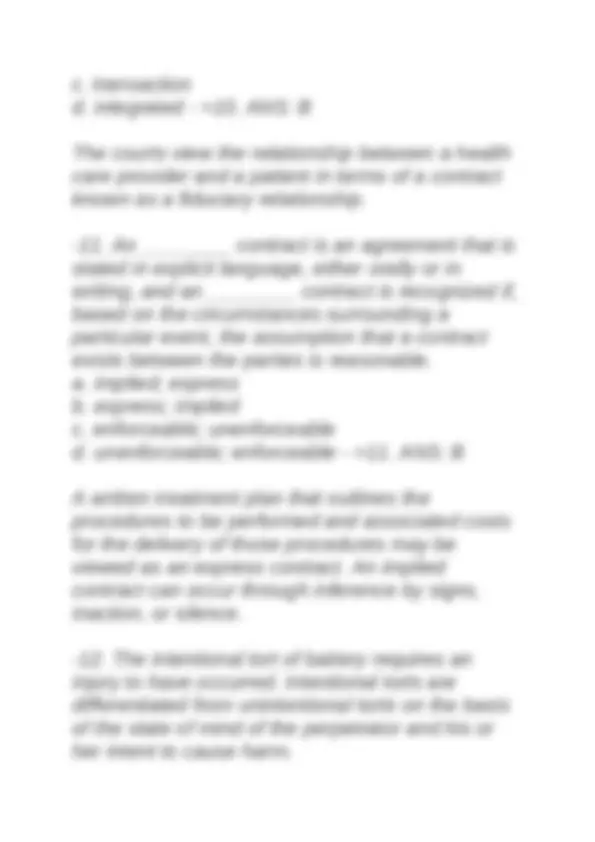
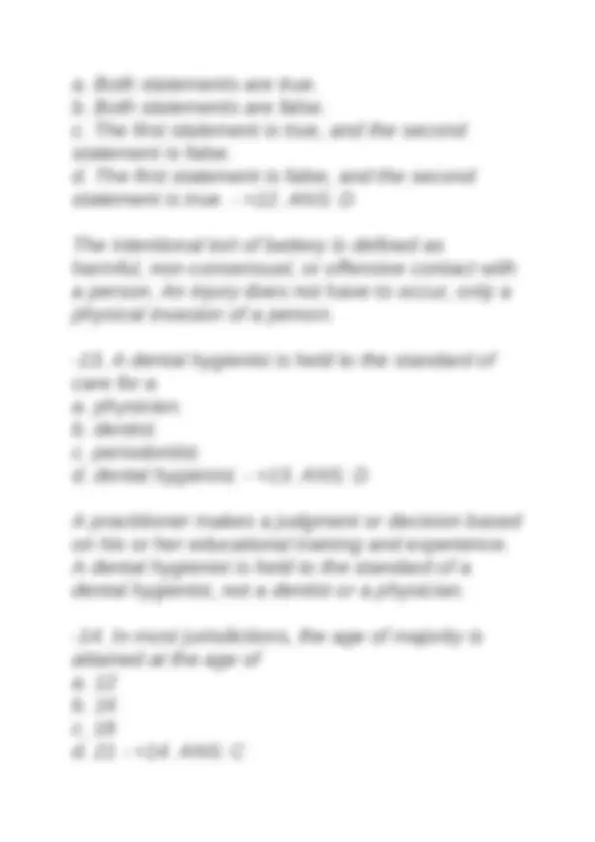
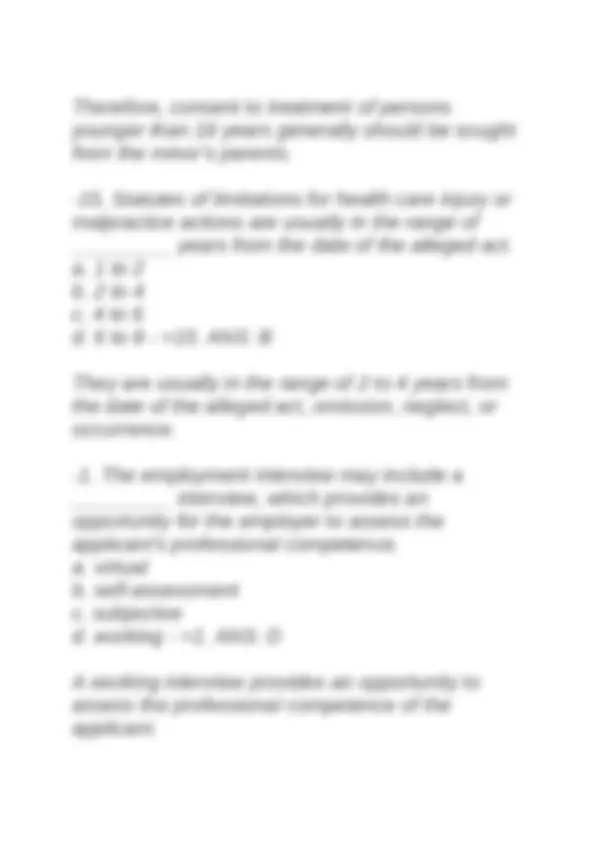
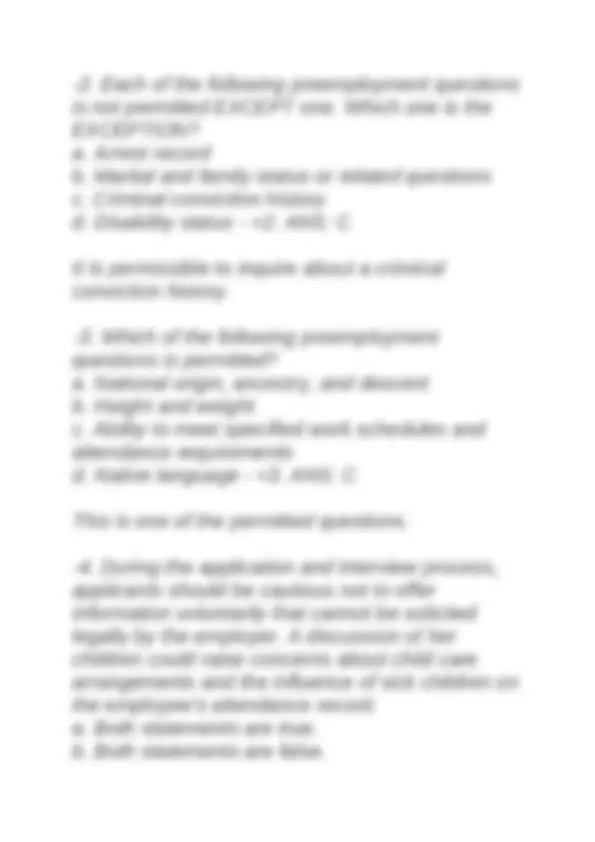
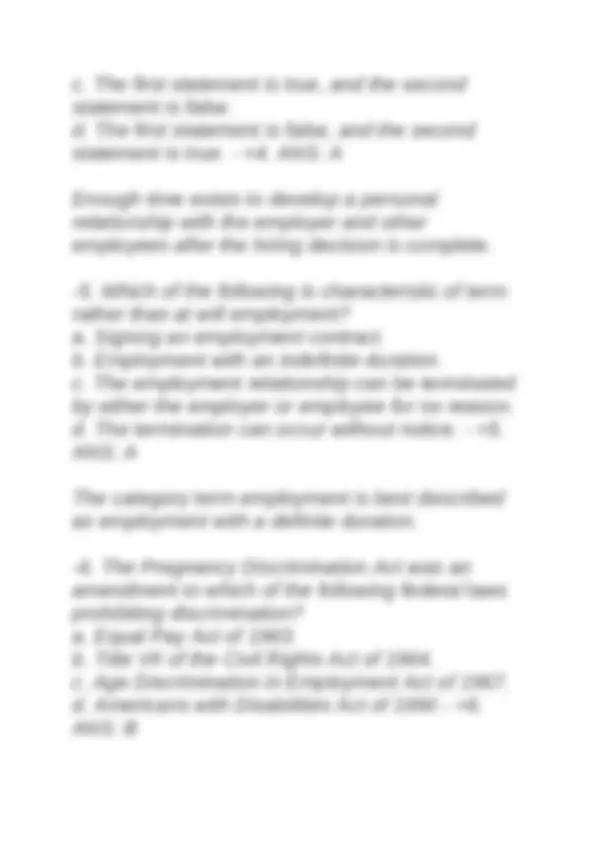
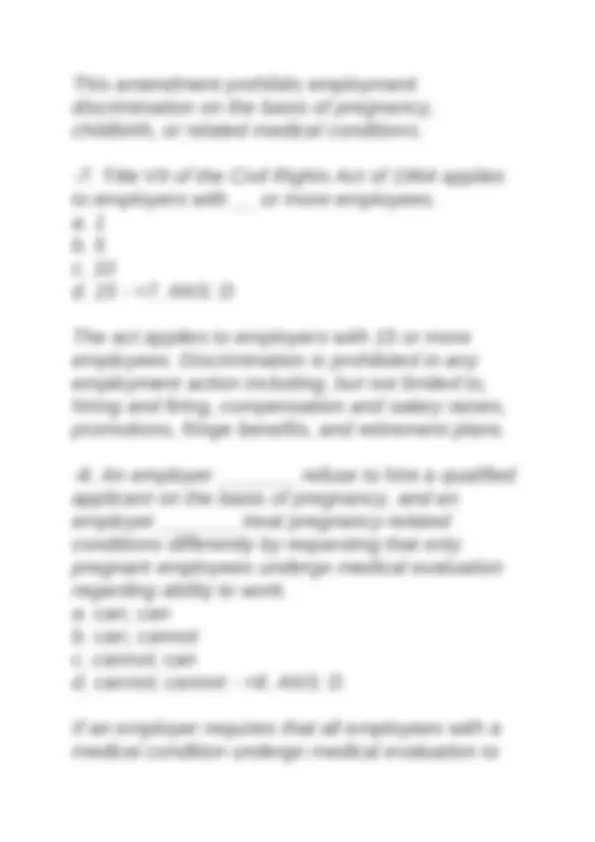
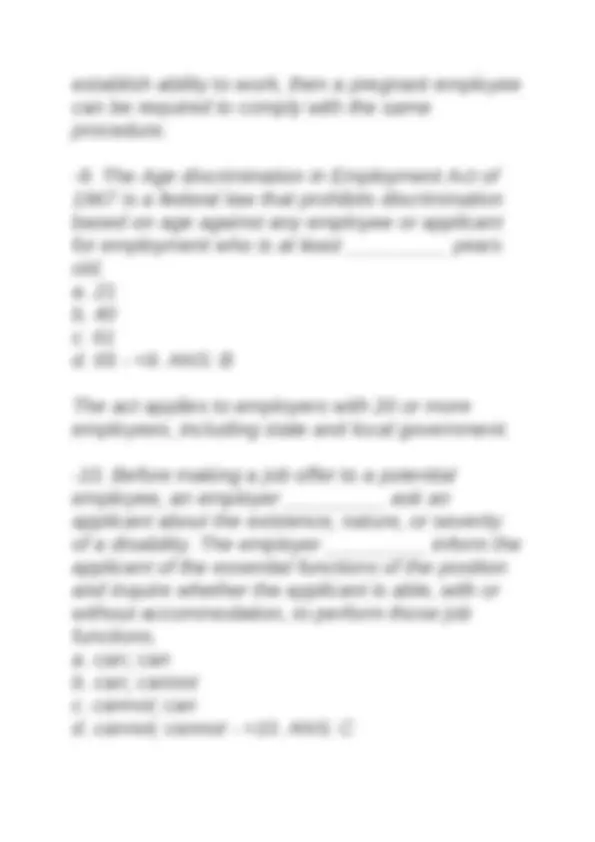
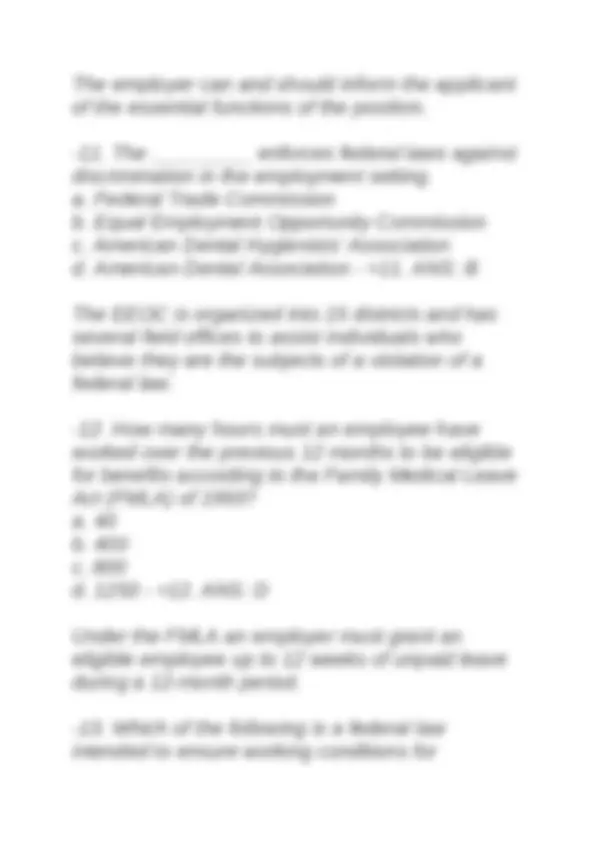
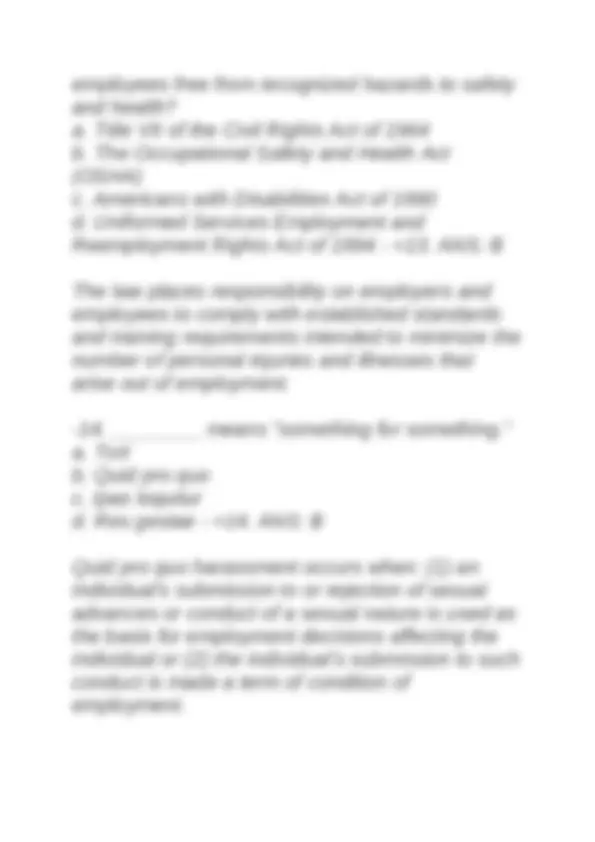
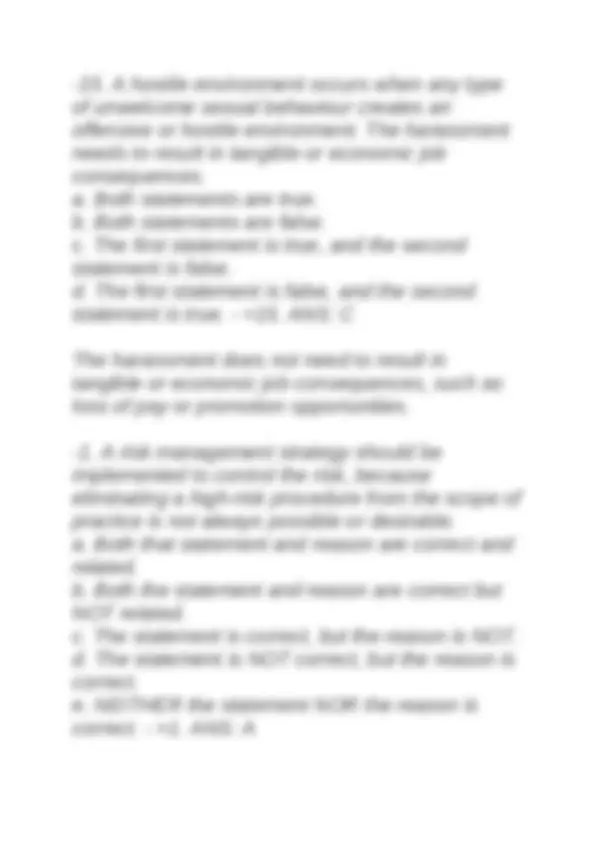
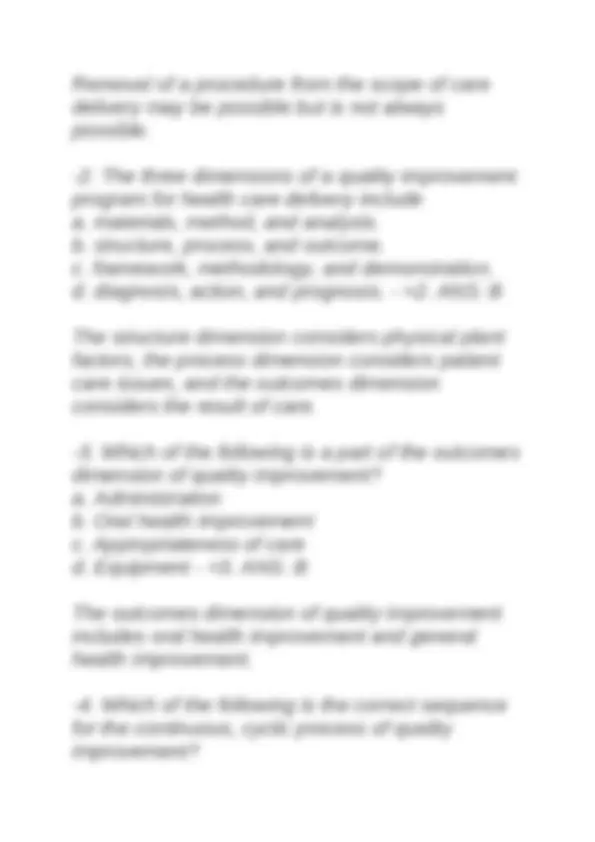
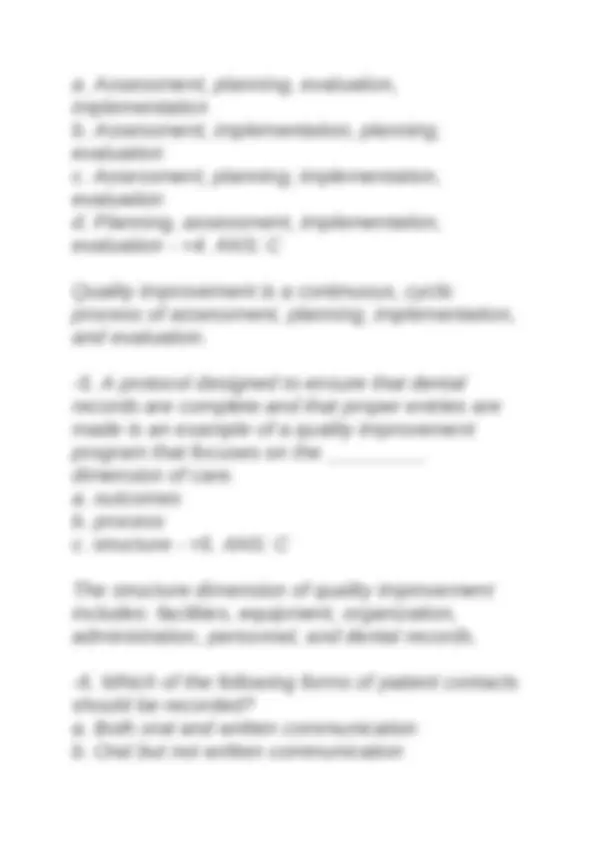
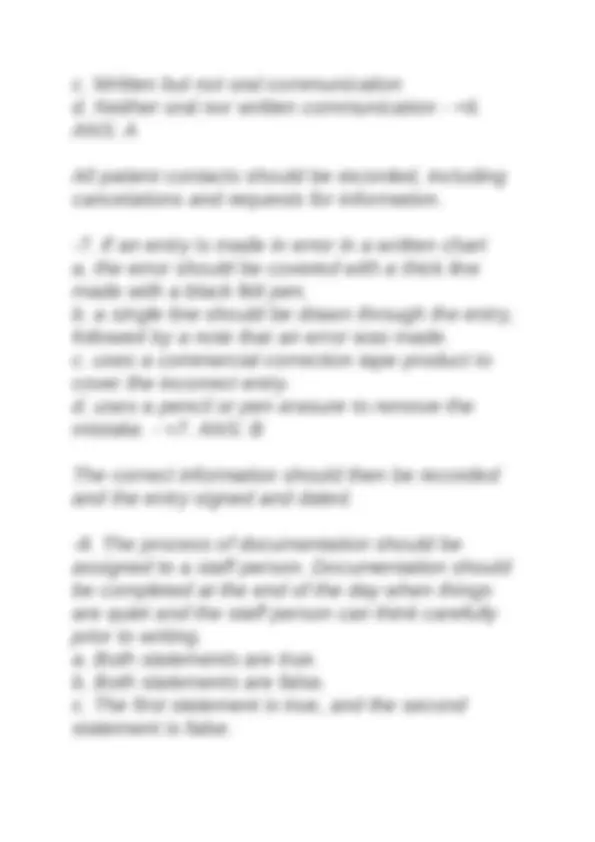
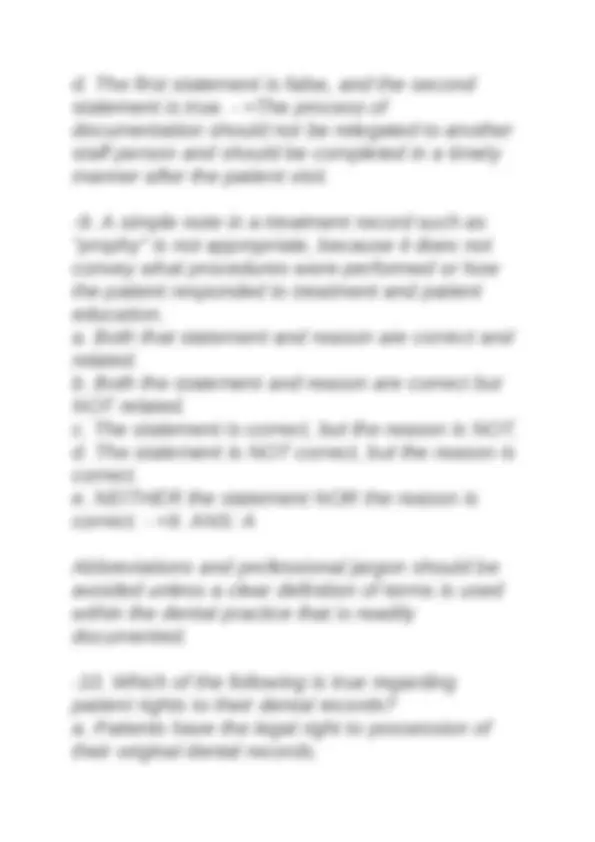
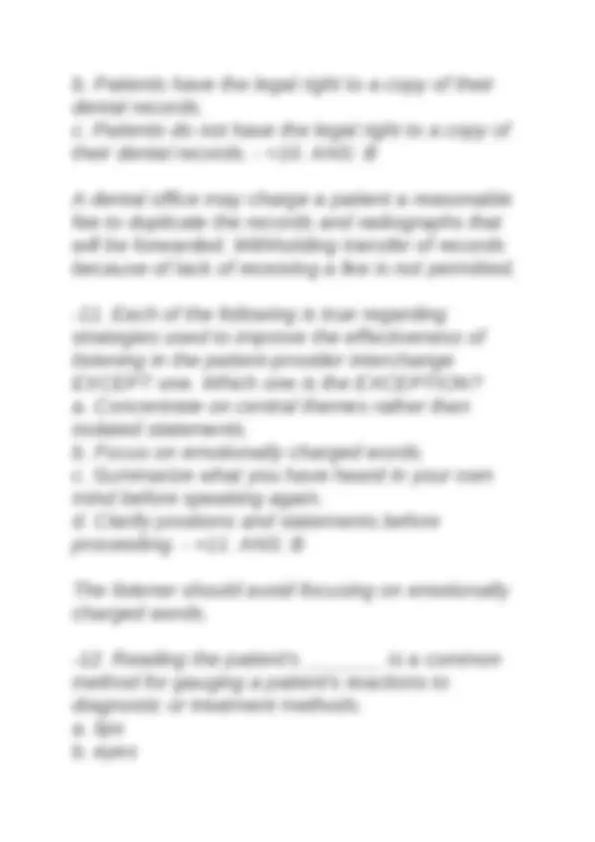
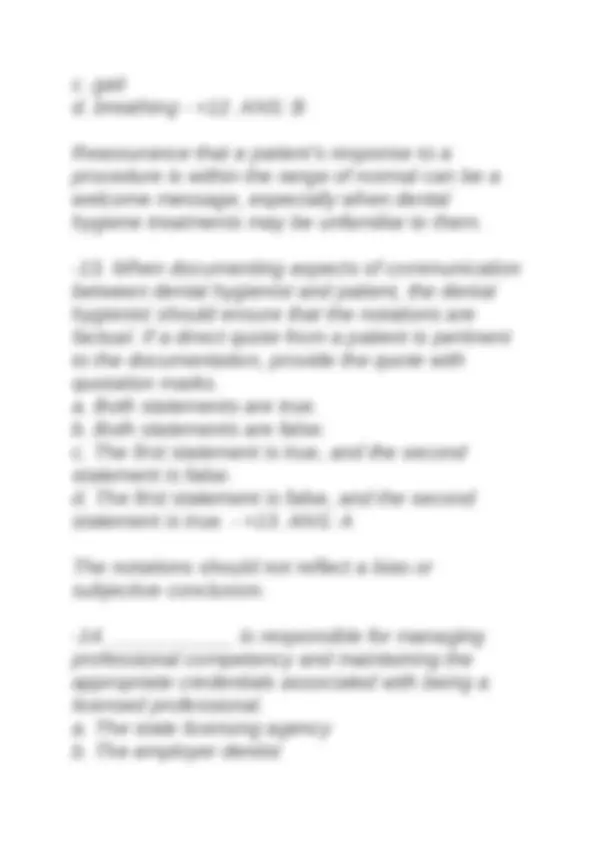
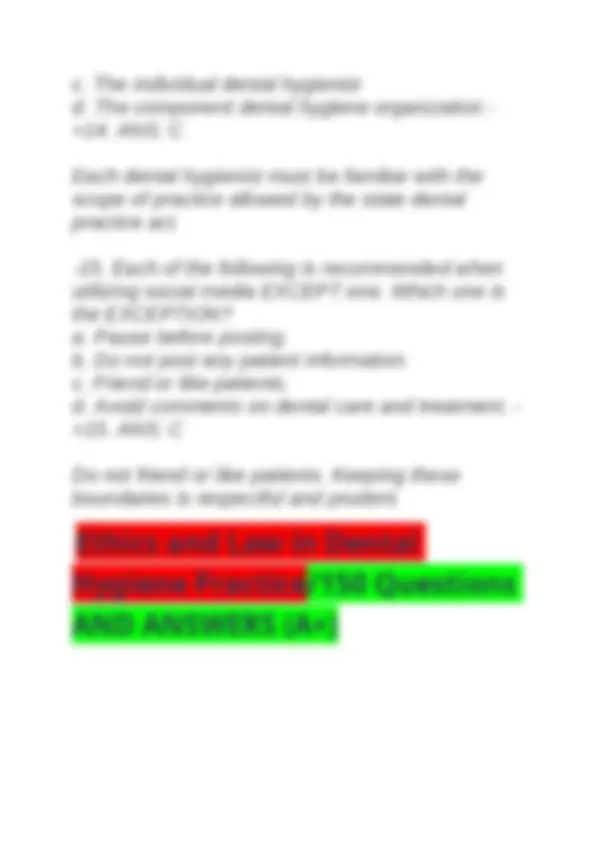
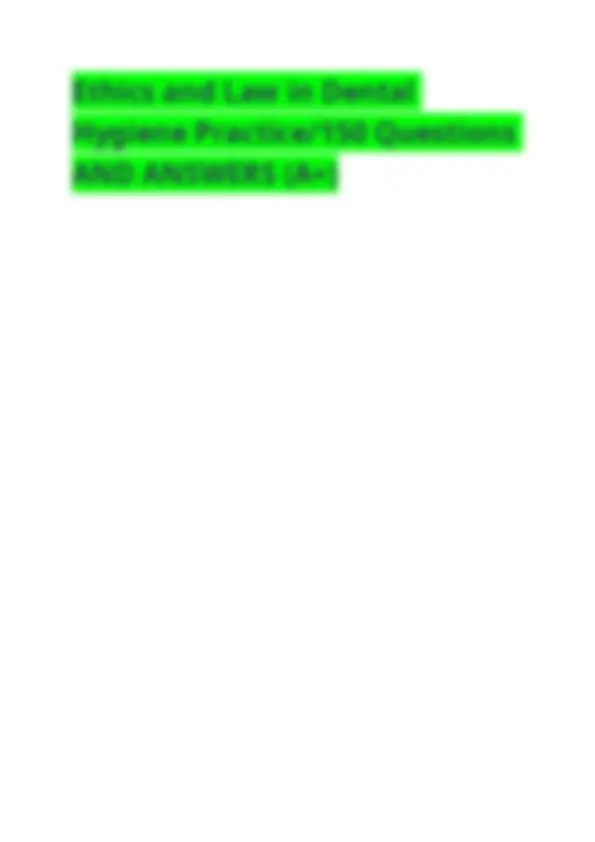


Study with the several resources on Docsity

Earn points by helping other students or get them with a premium plan


Prepare for your exams
Study with the several resources on Docsity

Earn points to download
Earn points by helping other students or get them with a premium plan
Community
Ask the community for help and clear up your study doubts
Discover the best universities in your country according to Docsity users
Free resources
Download our free guides on studying techniques, anxiety management strategies, and thesis advice from Docsity tutors
Ethics and Law in Dental Hygiene Practice150 Questions AND ANSWERS (A+)Ethics and Law in Dental Hygiene Practice150 Questions AND ANSWERS (A+)Ethics and Law in Dental Hygiene Practice150 Questions AND ANSWERS (A+)Ethics and Law in Dental Hygiene Practice150 Questions AND ANSWERS (A+)Ethics and Law in Dental Hygiene Practice150 Questions AND ANSWERS (A+)Ethics and Law in Dental Hygiene Practice150 Questions AND ANSWERS (A+)
Typology: Exams
1 / 75

This page cannot be seen from the preview
Don't miss anything!




































































Physician Charter" was to reinvigorate the value of professionalism that includes social responsibility: the ethic of care, and access to that care, for all members of society. -3. Which of the following models of professionalism described by Ozer is considered to be the most desirable? a. Commercial model b. Interactive model c. Guild model - =3. ANS: B The interactive model is preferable because it presents the patient and provider as partners who make different contributions to the partnership. This equal moral status creates an obligation for equal respect as partners working together toward attaining and maintaining oral health. -4. The term interprofessional education (IPE) refers to occasions when students from two or more health professions a. is combined into a single education program, for example, Registered Nurse (R.N.) and Licensed Practical Nurse (L.P.N.) or Osteopathic Physician (D.O.) and Allopathic Physician (M.D.). b. completes the degree requirements for more than one program, for example, an M.D. and a D.D.S.
provide standards for the evaluation of educational programs and schools? a. Standards b. Competencies c. Accreditation d. Uniformity - =6. ANS: C The Commission on Dental Accreditation is the specialized accrediting agency recognized by the United States Department of Education to accredit programs that provide basic preparation for licensure in dentistry, dental hygiene, and all related dental disciplines. -7. Which of the following is the top stage of competency according to the expert learning continuum? a. Competent b. Master c. Proficient d. Beginner e. Novice - =7. ANS: B The five stages are novice, beginner, competent, proficient, and master. Becoming an expert is not an end point, rather it is something a true professional constantly strives for in practice.
-8. Which of the following organizations developed the "Standards for Clinical Dental Hygiene Practice"? a. The American Dental Educators Association (ADEA) b. The American Dental Association (ADA) c. The American Dental Hygienists' Association (ADHA) d. The Association of State and Territorial Dental Directors (ASTDD) - =8. ANS: C The ADHA established the Standards for Clinical Dental Hygiene Practice in 1985 to outline the expectations for the practicing dental hygienist. The revised standards were validated in 2008 and reaffirmed in 2014 to lay out a framework for clinical practice that focuses on the provision of patient-cantered comprehensive care. -9. All of the professional traits of a health care professional are rooted in a. nonmaleficence. b. beneficence. c. veracity. d. integrity. - =9. ANS: B The professional traits are rooted in beneficence, the core of health care that places the needs of the patient or client ahead of those of the provider. Society expects and demands this behaviour from
The first virtue is self-effacement, which means putting aside all notions of self as better educated, socially superior, or more economically well off and focusing on the needs of the patient. The second is self-sacrifice, or putting aside or giving up one's own interests and concerns. -12. Maintaining current knowledge of dental hygiene theory and technique is one facet of which of the following professional traits of a dental hygienist? a. Loyalty b. Maturity and Self-Analysis c. Reliability and Responsibility d. Honesty and Integrity - =12. ANS: C Most states have a legal requirement for continuing education for those who hold a dental hygiene license or dental license. -13. Tolerance for others goes beyond the legal warning to not discriminate, because it means caring for all individuals who seek treatment whether or not they are likeable. a. Both that statement and reason are correct and related. b. Both the statement and reason are correct but NOT related. c. The statement is correct, but the reason is NOT.
d. The statement is NOT correct, but the reason is correct. e. NEITHER the statement NOR the reason is correct. - =13. ANS: A Patients occasionally will prove difficult and hostile during the course of treatment, but the dental hygienist must still treat them to the best of his or her ability. -14. The responsibility and power for legislative protection of the public rest with the dental schools and dental hygiene programs. The primary purpose of licensure is to protect the health and safety of the public. a. Both statements are true. b. Both statements are false. c. The first statement is true, and the second statement is false. d. The first statement is false, and the second statement is true. - =14. ANS: D Legislative protection of the public rests with each individual state or territory, not dental schools or dental hygiene programs. Licensure is designed to enforce practice codes, establish standards, and sanction incompetent practitioners, all for the purpose of protecting the health and safety of the public.
d. Participant involvement in discussion of moral dilemmas. - =2. ANS: D A review of moral education programs revealed that almost half were effective in promoting moral development, especially if the program lasted longer than a few weeks and if the program involved the participants in discussions of controversial moral dilemmas. Adults also seemed to gain more from such programs than did younger children. -3. A person's cognitive moral development _________ stop developing at a specific age, and their ability to employ what they understand in actual decisions ________ stop developing at a specific age. a. does; does b. does; does not c. does not; does d. does not; does not - =3. ANS: D Neither a person's cognitive moral development nor their ability to employ what they understand in actual decisions is frozen at some specified age. -4. Which of the following is true of Piaget's theory of cognitive moral development? a. The model consists of three stages of moral development.
b. The model defined moral development according to both levels and stages. c. The model is developed according to the ethic of care. d. The model categorized stages in the moral development of male children. - =4. ANS: D Both Piaget and Kohlberg categorized stages in the moral development of male children. Piaget's model consisted of four stages, whereas Kohlberg defined moral development according to both levels and stages. Gilligan's model is based on morality in the context of a relationship she calls the ethic of care. -5. Which of the following is Stage 1 of Piaget's Four-Stage Model of Moral Development? a. Heteronomous stage b. Autonomous stage c. Amoral stage d. Egocentric stage - =5. ANS: C Stage 1 is the amoral stage, which occurs between ages 0 and 2 years. The amoral stage is followed by the egocentric stage (ages 2 to 7 years); the heteronomous stage (ages 7 to 12 years); and the autonomous stage (ages 12 and older).
b. Instrumental relativist orientation c. social contract legalistic orientation d. Universal ethical principal orientation - =8. ANS: D Stage 6 is the universal ethical principal orientation, the highest stage of Kohlberg's Model of Moral Development. -9. Gilligan believes that complete moral development occurs in the context of a. both male justice orientation and a female ethic of care. b. the male justice orientation but not female ethic of care. c. the female ethic of care but not male justice orientation. d. neither the male justice orientation nor the female ethic of care. - =9. ANS: A Gilligan believes that complete moral development occurs in the context of two moral orientations—a male justice orientation and a female ethic of care —and therefore that Kohlberg's measurement of moral development only in a justice-oriented scoring system is biased toward the male. -10. According to which of the following persons, the duty to report a case of suspected child abuse is derived from the relationships surrounding the
child and the need to protect the interests of the child? a. Lawrence Kohlberg b. Jean Piaget c. Carol Gilligan d. Immanuel Kant - =10. ANS: C According to Gilligan, for a female health care provider, even if her actions turned out to be identical with those of the male, the basis of those actions being ethically required would be different; the duty to report—and her actually reporting if she determines this is her most important duty—is derived from the relationships surrounding the child and the need to protect the interests of the child. -11. Experiences, as we make sense of them, in turn change the basic conceptual structures by which people construct a. nostalgia. b. meanings. c. a hierarchy. d. a framework. - =11. ANS: B The basic tenet of cognitive development theory is that people operate on their experiences to make sense of them, and those experiences, as we make sense of them, in turn change the basic
-14. Which of the following ethical theories proposes that some actions are required by the rightness or wrongness of the action, regardless of the consequences of the action? a. Utilitarian ethics b. Deontology c. Consequentialism d. Virtue ethics - =14. ANS: B Whereas consequentialists focus on the consequences of an act, deontologists argue that some acts are right or wrong independent of their consequences. -15. The concept of a universal law in ethical thinking was developed by a. John Stuart Mill b. Immanuel Kant c. Aristotle d. Plato - =15. ANS: B Kant held that the test of any rule of conduct is whether it can be a duty for all human beings to act on—what he called a universal law. -1. The main normative principles in health care are nonmaleficence, beneficence, autonomy and a. veracity. b. justice.
c. confidentiality. d. paternalism. - =1. ANS: B These principles are associated with expectations for behaviour, and they provide guidelines in dealing with right and wrong actions. These principles provide direction about what should and should not be done in specific situations. -2. If a dentist intentionally charges an insurance company for procedures not performed it is an ethical dilemma, because an ethical dilemma occurs when one or more ethical principles are in conflict. a. Both that statement and reason are correct and related. b. Both the statement and reason are correct but NOT related. c. The statement is correct, but the reason is NOT. d. The statement is NOT correct, but the reason is correct. e. NEITHER the statement NOR the reason is correct. - =2. ANS: D An ethical dilemma occurs when one or more ethical principles are in conflict. It is different from a situation in which a dentist is knowingly and intentionally charging an insurance company for procedures not performed.
Principles derive from common morality and the traditions of health care, specifically from some of the role obligations of practicing medical clinicians. -5. A hygienist who is unfamiliar with placing dental sealants should a. performs the procedure without informing the patient because he or she will learn best by doing it. b. performs the procedure and inform the patient that he or she is a beginner. c. defers placing sealants until achieving competency. d. never performs the procedure again for the remainder of his or her career. - =5. ANS: C A dental hygienist has the obligation to stay up to date with the changing standards of care in the profession. A hygienist who is unfamiliar with sealant placement procedures or anaesthesia techniques should defer performing that service until achieving competency. -6. Causing some degree of harm when that harm will lead to a greater good may be desirable as well as necessary according to the principle of double effect which is part of the principle of a. no maleficence. b. beneficence.
c. autonomy. d. justice. - =6. ANS: A A health care provider may not always be able to avoid harm. The principle of double effect requires the health care provider to consider the risks and benefits whenever treatment is provided. -7. Avoiding harm _______ always possible and promoting good _____ always possible in the practice of dental hygiene. a. is; is b. is; is not c. is not; is d. is not; is not - =7. ANS: D Avoiding harm and promoting good in the practice of dental hygiene and dentistry are not always possible. -8. Both nonmaleficence and beneficence require the physician to do what will best benefit the patient, which is a _____________ approach. a. male justice orientation b. female ethic of care c. consequentialist or utilitarian d. no consequentialist or deontological - =8. ANS: C